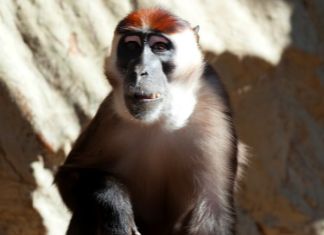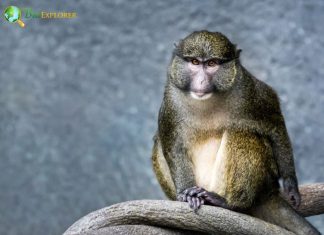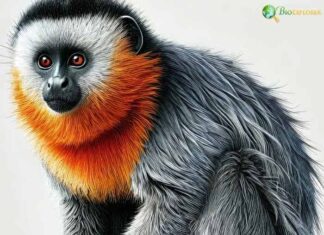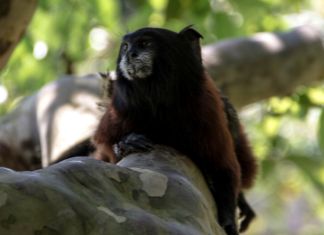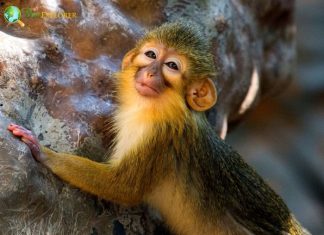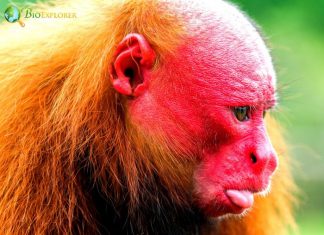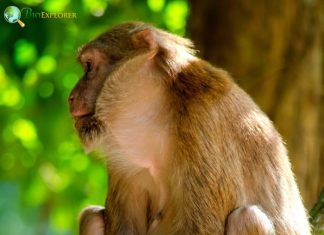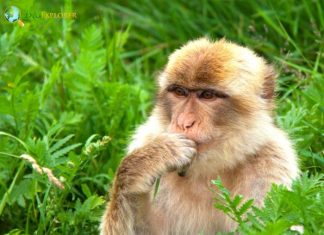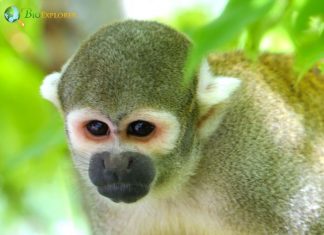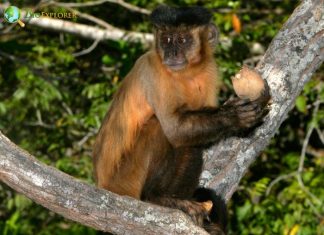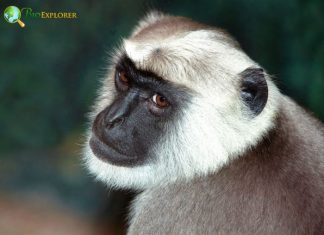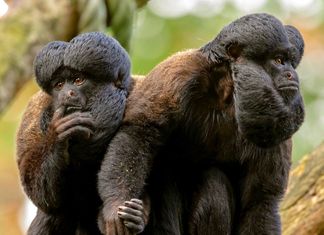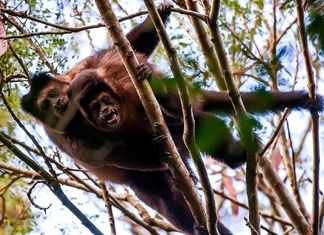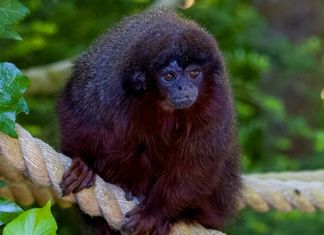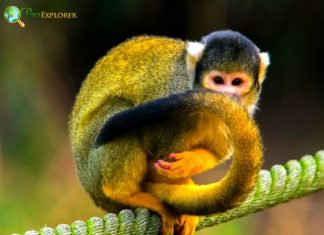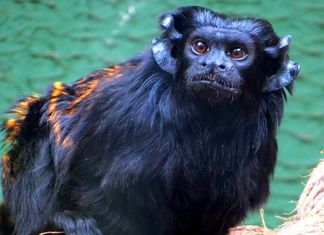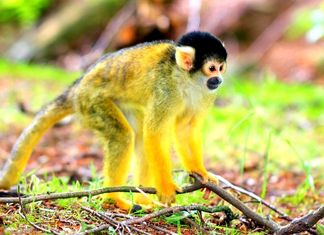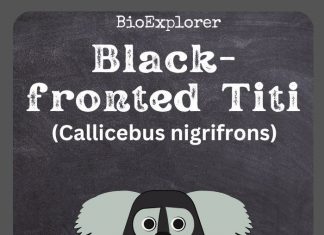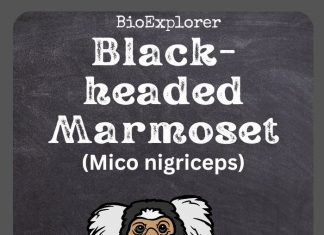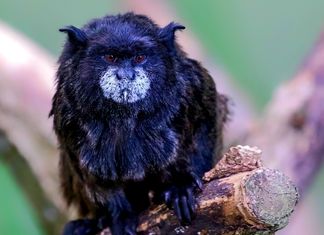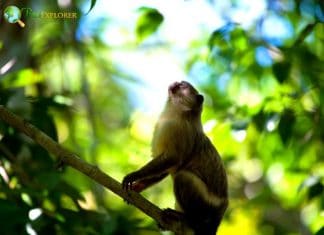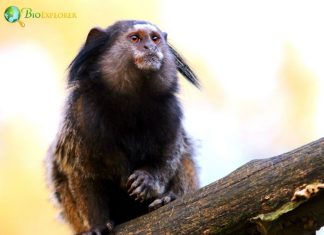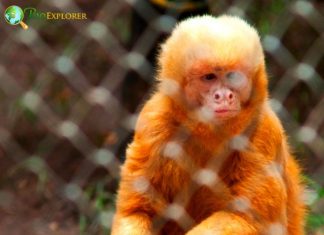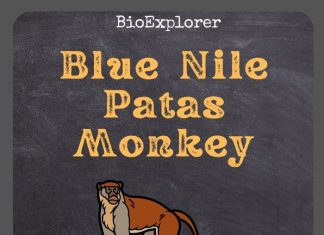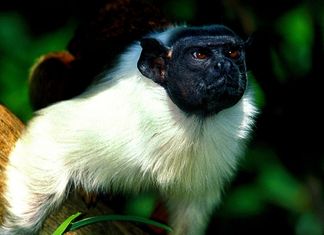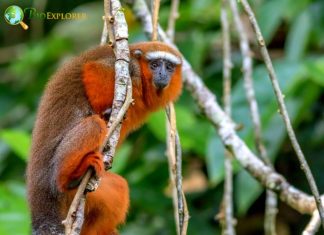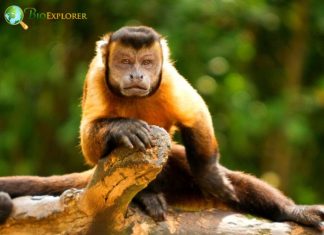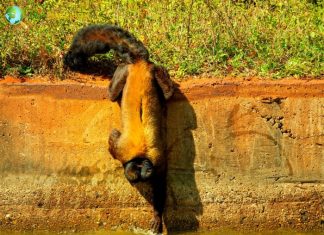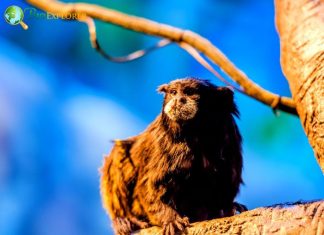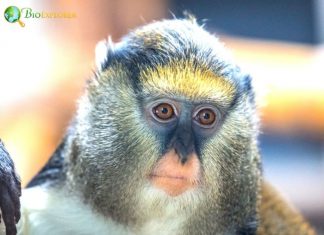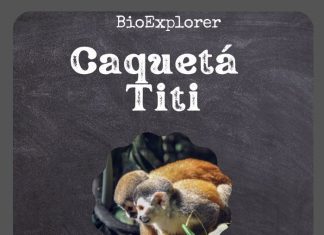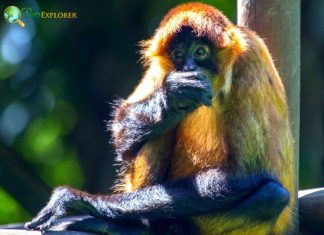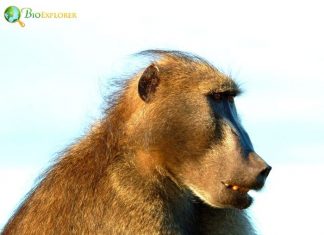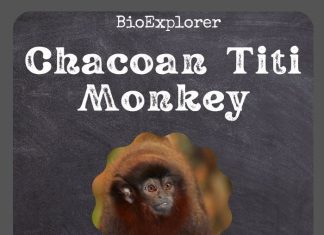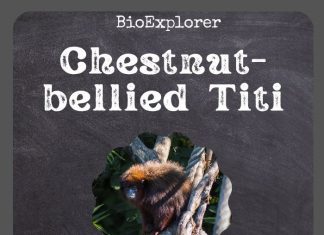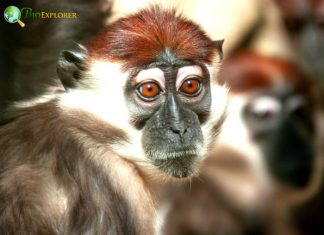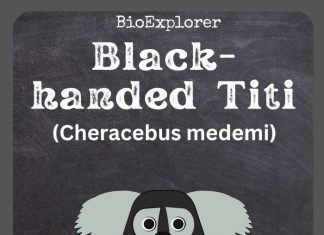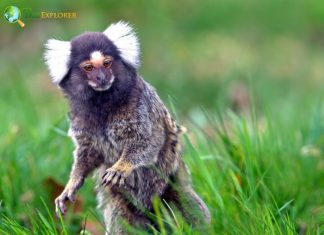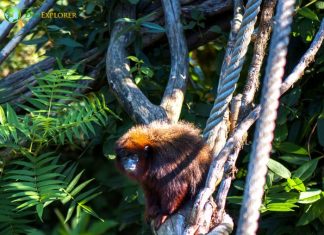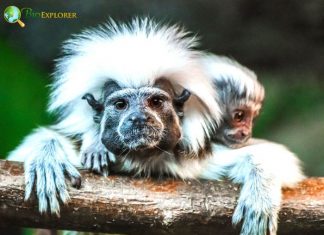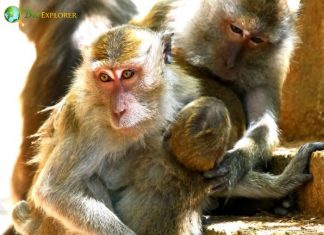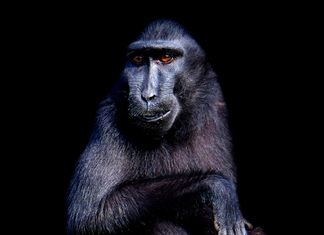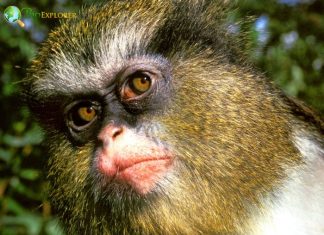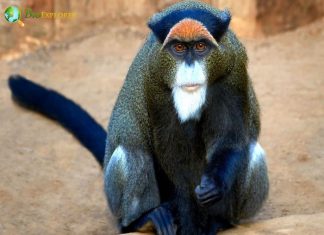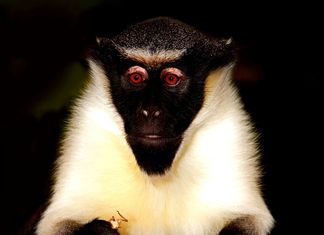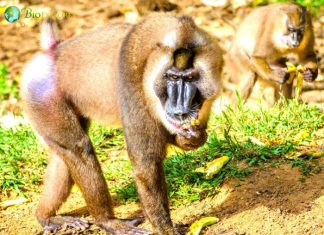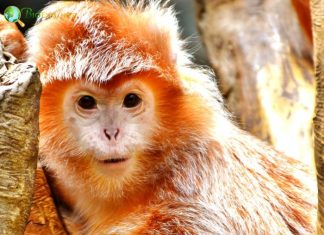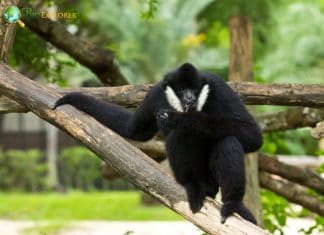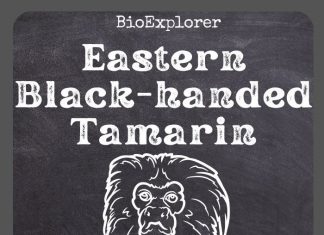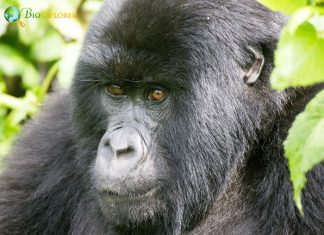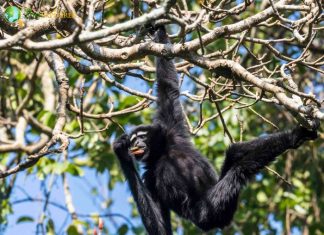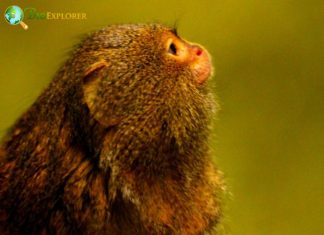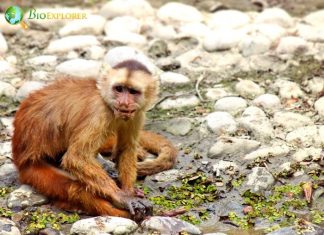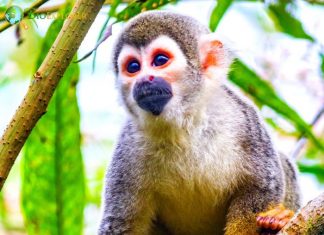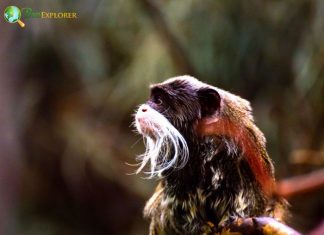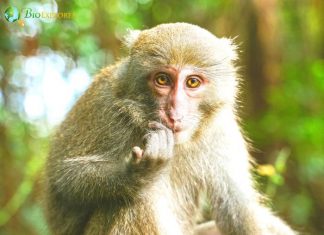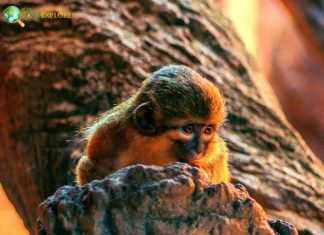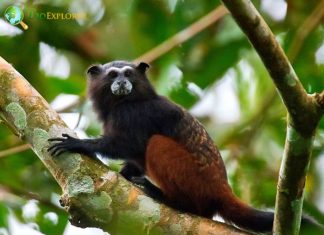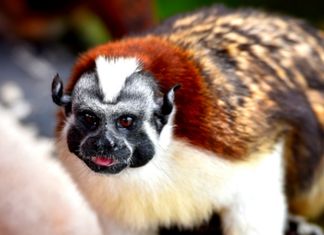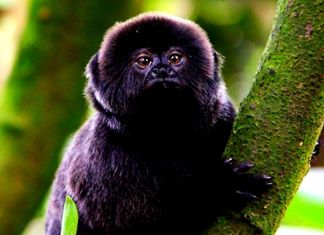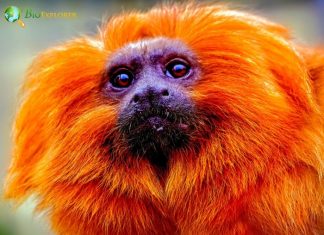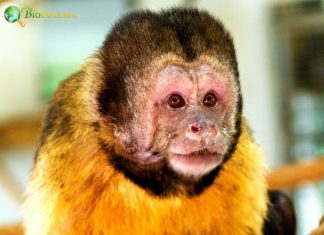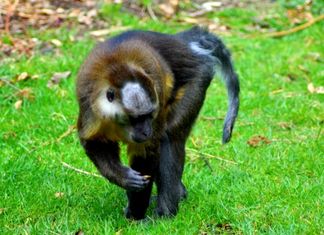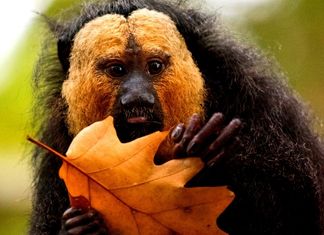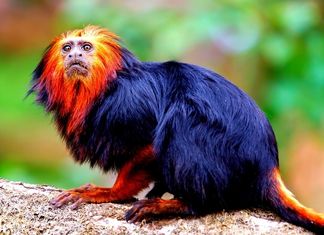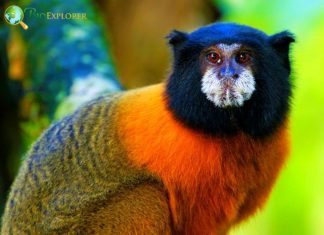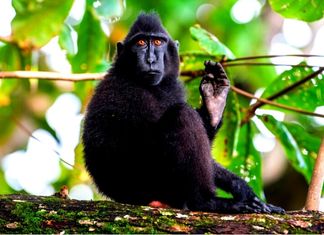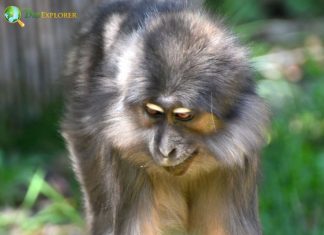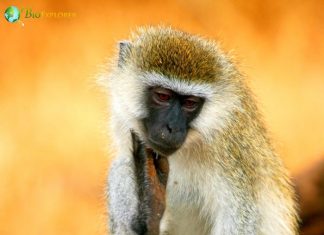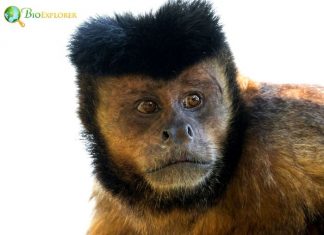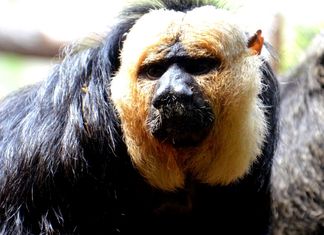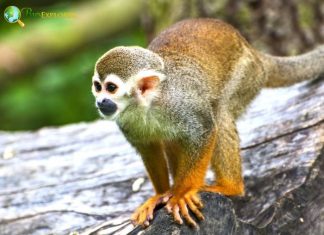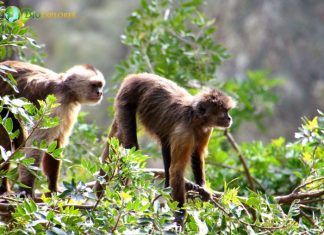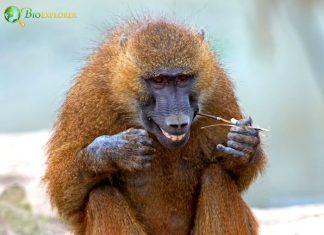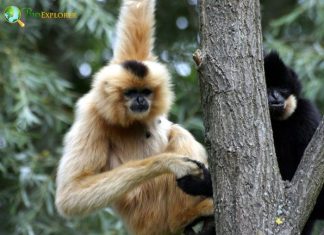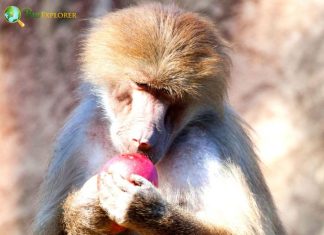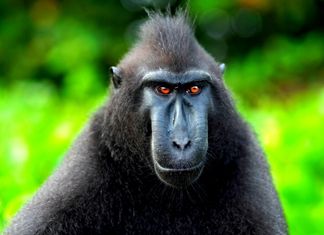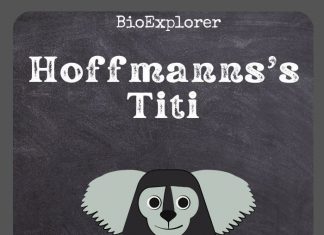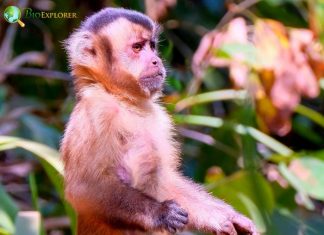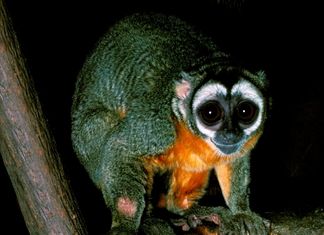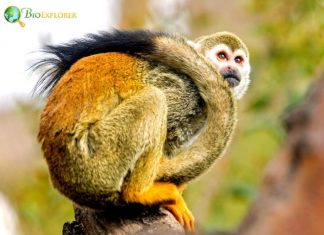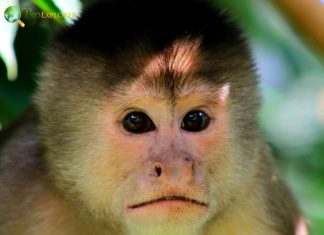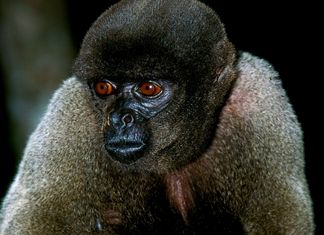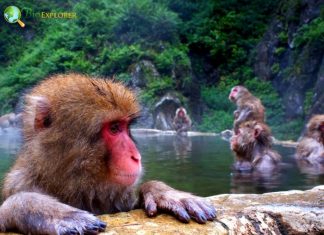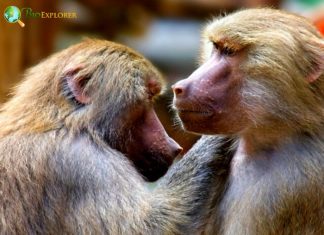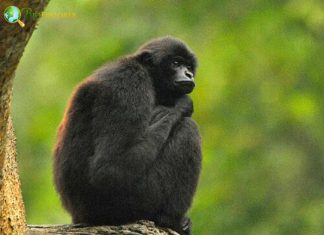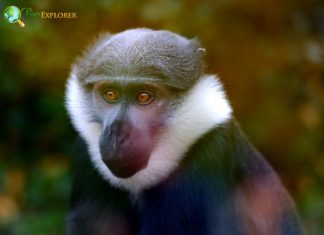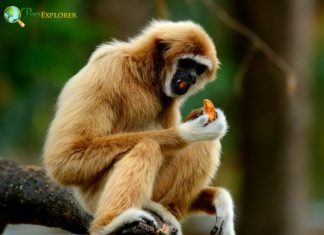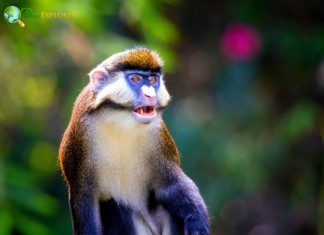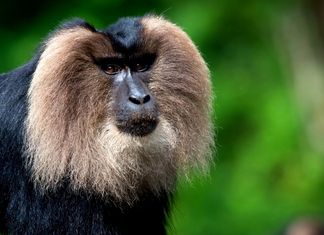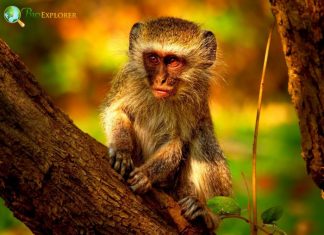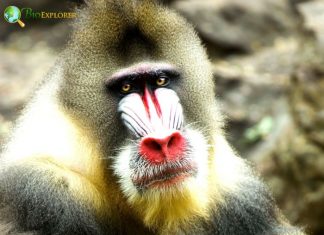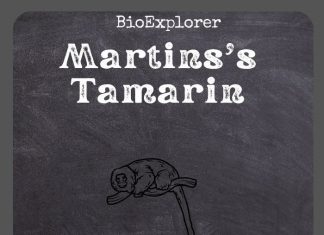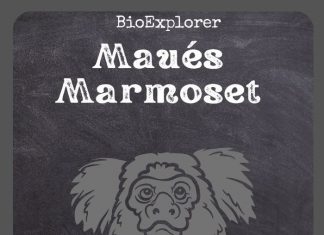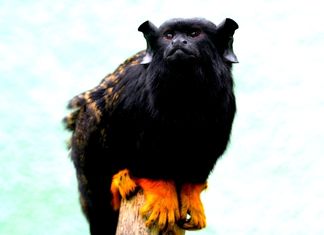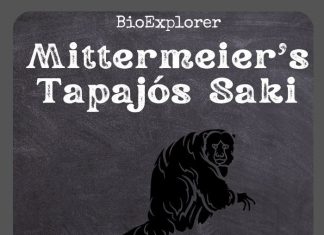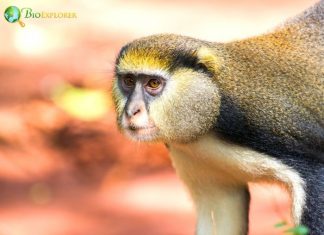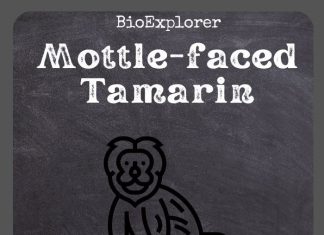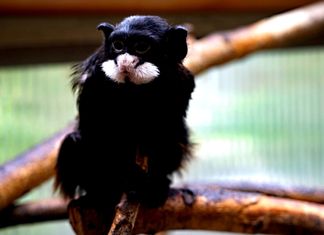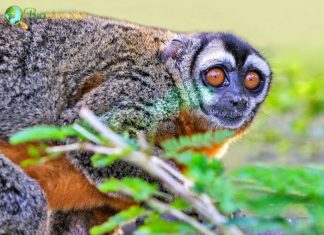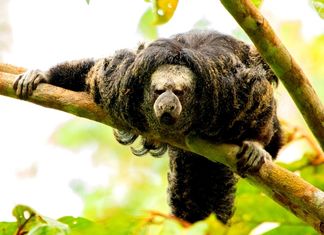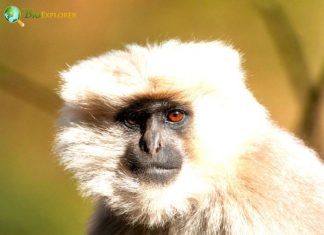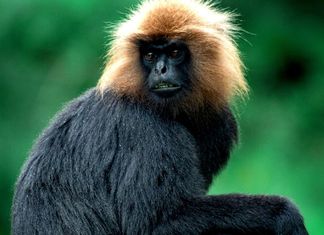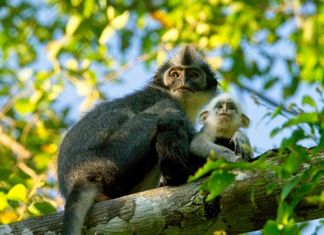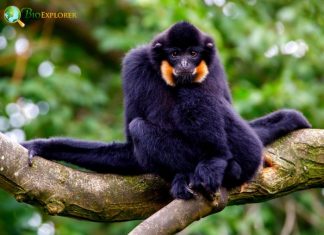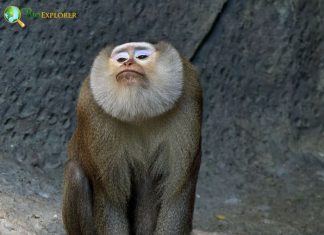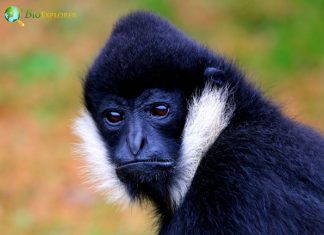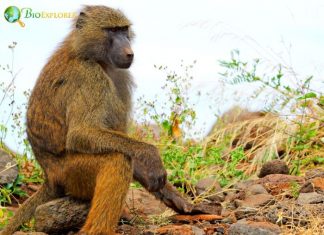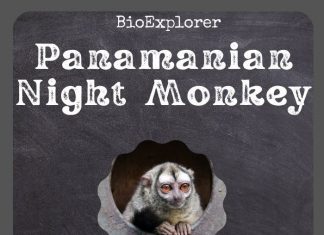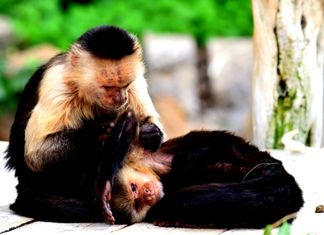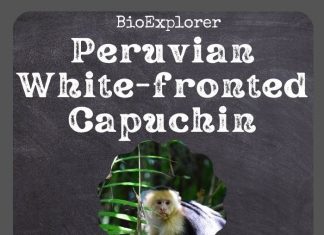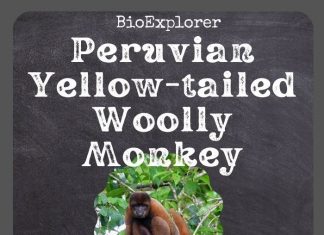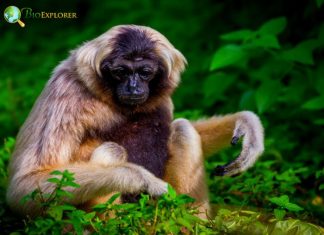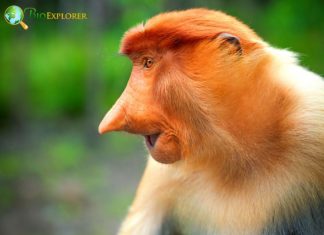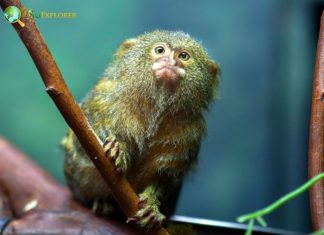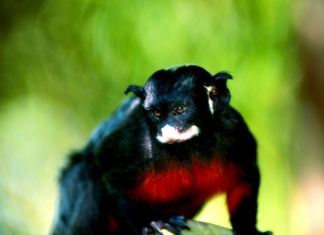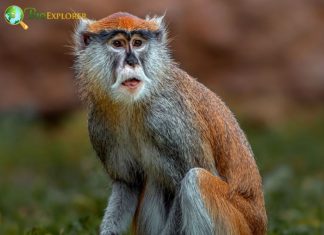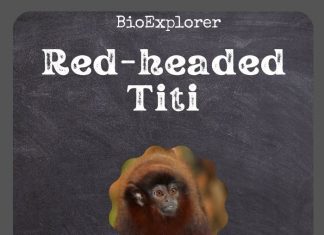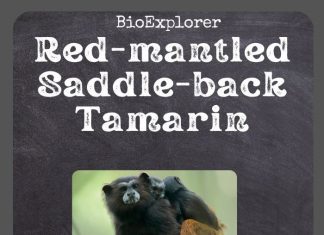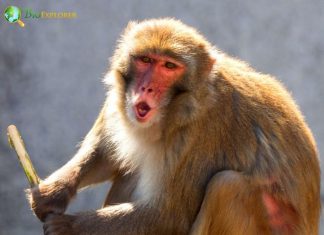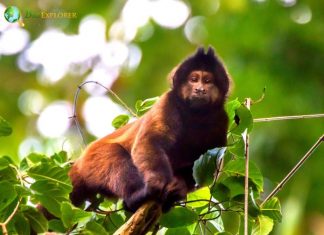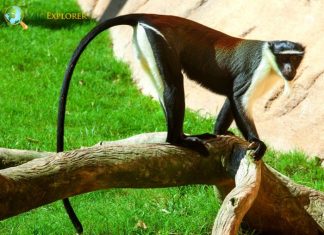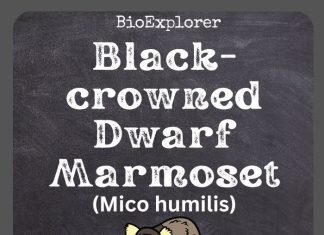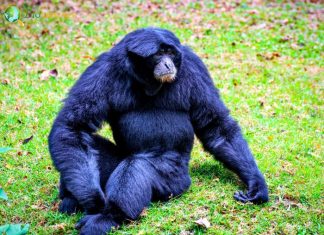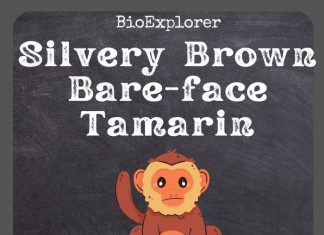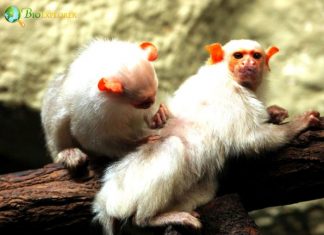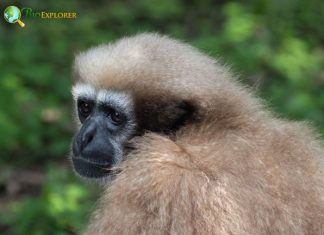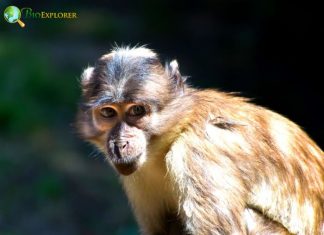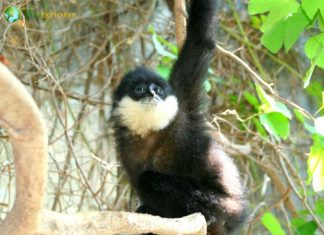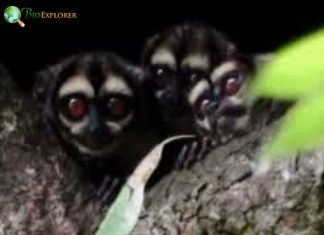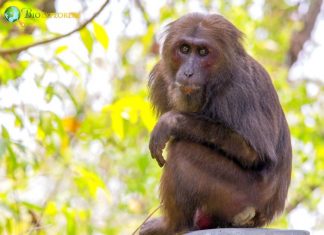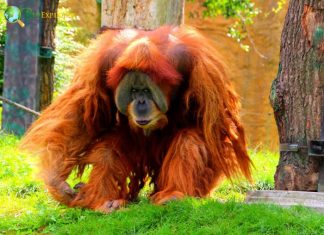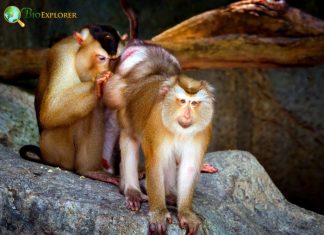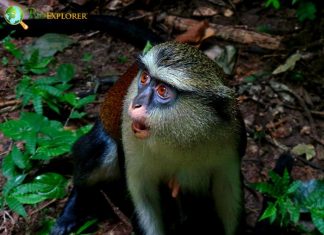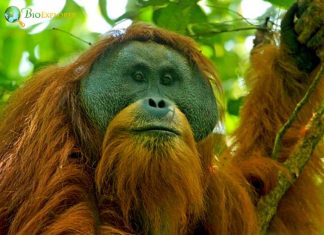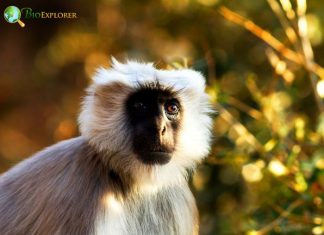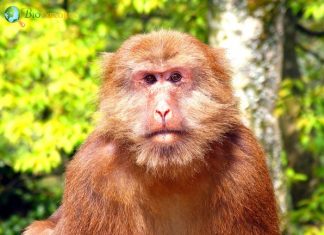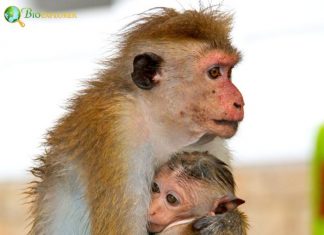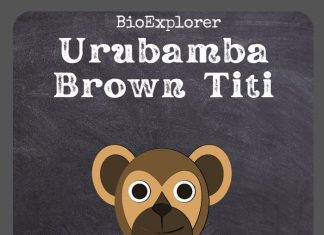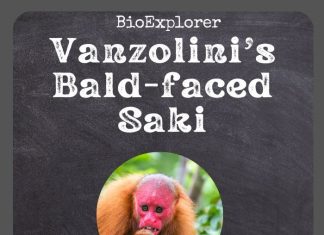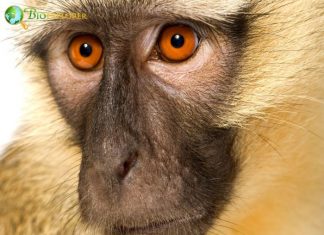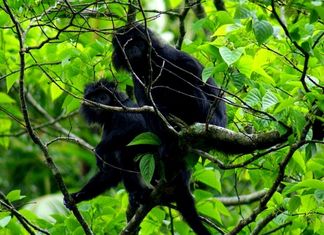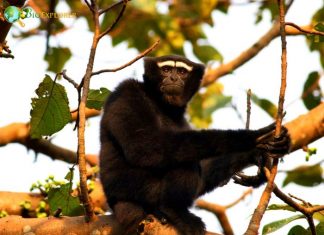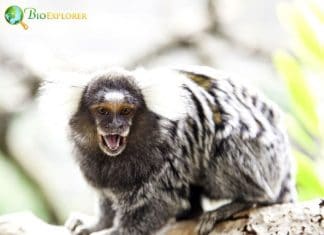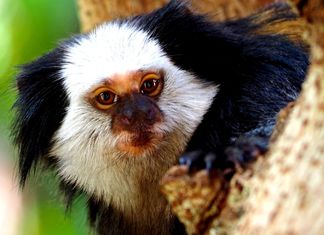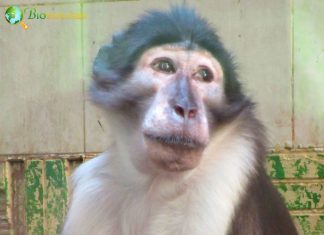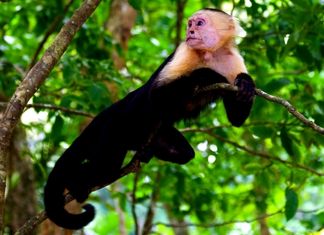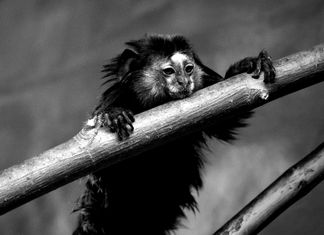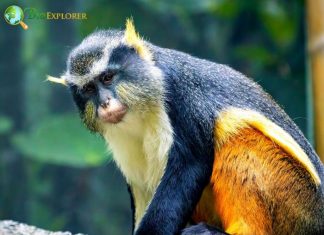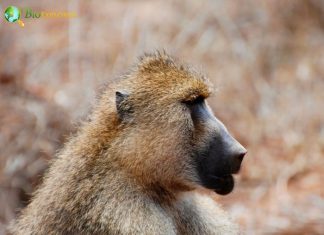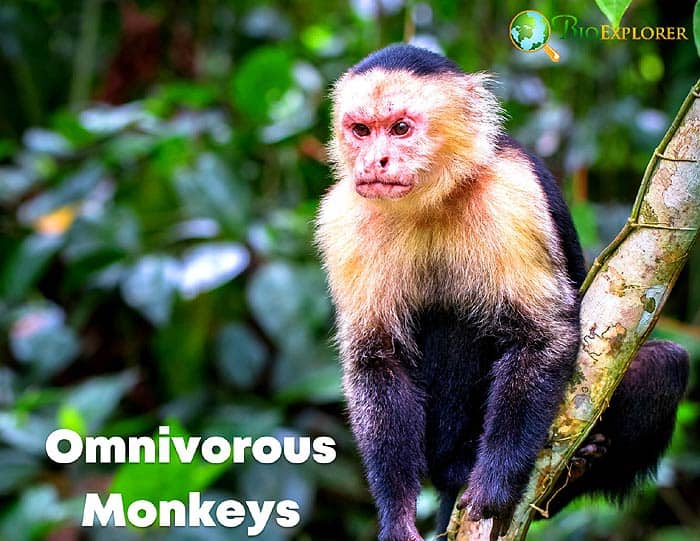
Omnivore monkeys have the ability to feed and survive on plant and animal matters. These monkeys obtain energy and nutrients by extracting carbohydrates, protein, fat, and fiber from these organic matters.
These monkeys are the largest number of species by population (216 monkeys) within the omnivorous diet category.
Omnivorous Monkeys
Agile Mangabey
Species Name: Cercocebus agilisDiet: Omnivorous
The Agile Mangabey is another Old-World monkey of the White-Eylid Mangabey group mainly found in swampy forests. Due to habitat loss, mangabeys are now listed as endangered, both male and female.
Allen’s Swamp Monkey
Species Name: Allenopithecus nigroviridisDiet: Omnivorous
Allen's swamp monkeys are small, stocky monkeys with gray to brown fur and long tails. These highly social primates live in the swamp forests of central Africa, where they mostly spend their time in the trees. It was named after Joel Asaph Allen, an American zoologist.
Alta Floresta Titi
Species Name: Plecturocebus grovesiDiet: Omnivorous
The Alta Floresta titi is a distinct but unnamed form of titi (Plecturocebus) rediscovered in 2019 in Chapada dos Parecis, a plateau in the far south of the Brazilian state of Rondônia. This species lives exclusively between the Teles-Pires and Juruena rivers in Mato Grosso.
Andean Saddle-back Tamarin
Species Name: Leontocebus leucogenysDiet: Omnivorous
The Andean saddle tamarin, also known as the saddleback tamarin (formerly known as the brown-mantled tamarin), is a New World monkey species. Andean saddleback monkeys are considered "phyletic dwarfs," meaning their small size is related to their evolutionary development.
Angolan Talapoin
Species Name: Miopithecus talapoinDiet: Omnivorous
Also known as the Southern talapoin, Angolan talapoin is a primate species in the Cercopithecidae family. Tail color varies from grayish-black to brownish-black above and is yellow or yellowish-gray below. The Angolan talapoin monkeys are among the smallest species of Old-World monkeys.
Aracá Uakari
Species Name: Cacajao ayresiDiet: Omnivorous
The Aracá uakari, also called the Ayres black uakari, is a newly described monkey species endemic to the northwestern Brazilian Amazon. The species was found by Jean-Philippe Boubli of the University of Auckland after following local Yanomamo Indians on their hunts along the Aracá River, a northern tributary of the Negro River.
Assam Macaque
Species Name: Macaca assamensisDiet: Omnivorous
The Assam macaque, also known as Assamese macaque, is a macaque of the Old-World monkey family endemic to South and Southeast Asia. Assam is another state in India. Eating everything from fruits to 55 types of flowers, leaves, seeds, and bark, these macaque monkeys adapt their diet to suit their habitat.
Barbara Brown’s Titi
Species Name: Callicebus barbarabrownaeDiet: Omnivorous
Barbara Brown's titi also known as the northern Bahian blond titi or blond titi monkey, is a New World monkey species. Barbara Brown's titi is named in honor of Barbara Elaine Russell Brown, a zoologist.
Barbary Macaque
Species Name: Macaca sylvanusDiet: Omnivorous
The Barbary macaque, also called the Magot macaque, is a macaque endemic to the Atlas Mountains in Morocco and Algeria and a small introduced population in Gibraltar. Before the Ice Age, they inhabited the Mediterranean coasts and most of Europe, as far away as the British Isles and Germany.
Bare-eared Squirrel Monkey
Species Name: Saimiri ustusDiet: Omnivorous
The bare-eared squirrel monkey also called the golden-backed squirrel monkey, is a subspecies of the Saimiri sciureus group native to the tropical forests and jungles of South and Central America. The bare-eared squirrel monkey differs from other species because it does not have ear tufts.
Bearded Capuchin
Species Name: Sapajus libidinosusDiet: Omnivorous
The bearded capuchin, also called the black-striped capuchin, is a New World monkey in the Cebidae family. They are found in central and northern Brazil. Until recently, the bearded capuchins were considered a subspecies of Tufted Capuchins.
Bearded Saki
Species Name: Chiropotes chiropotesDiet: Omnivorous
The bearded sakis or cuxiús are five species of New World monkeys classified in the genus Chiropotes. Bearded saki shows slight sexual dimorphism: males are usually taller and have longer, more prominent beards than females.
Bengal Sacred Langur
Species Name: Semnopithecus entellusDiet: Omnivorous
The Bengal sacred langur, also known as Hanuman's langur and the northern plains gray langur, is a primate species in the Cercopithecidae family. The Bengal sacred langurs are often referred to as "Hanuman's langurs", named after Lord Hanuman - the Hindu god.
Black Bearded Saki
Species Name: Chiropotes satanasDiet: Omnivorous
The black-bearded saki is a species of bearded saki, a species of New World monkey, one of the five remaining monkeys of its kind. Another striking feature is its signature beards. This species prefers primary rainforest, where lush tree canopies provide a relatively safe area out of sight and out of reach of several predators.
Black Capuchin
Species Name: Sapajus nigritusDiet: Omnivorous
The black capuchin, also called the black-horned capuchin, is a capuchin monkey native to the Atlantic rainforest of southeastern Brazil and extreme northeastern Argentina. The black capuchin was originally called Cebus nigritus or Cebus apella nigritus. Although this has changed, many sources still name the black capuchin as part of the Cebus genus.
Black Lion Tamarin
Species Name: Leontopithecus chrysopygusDiet: Omnivorous
The black lion tamarin, also called the golden-rumped lion tamarin, is a lion tamarin native to the Brazilian state of Sao Paulo, almost exclusively in Morro do Diabo State Park. Its limited geographic range makes it the rarest of the New-World monkeys.
Black Squirrel Monkey
Species Name: Saimiri vanzoliniiDiet: Omnivorous
The black squirrel monkey, also called the black-headed squirrel monkey or the blackish squirrel monkey is a small New-World monkey native to the central Amazonian region of Brazil. The black squirrel monkey closely resembles the much more common Bolivian squirrel monkey. However, the latter lacks the central black back.
Black Tamarin
Species Name: Saguinus nigerDiet: Omnivorous
Also known as western black-handed tamarind, the black tamarind is a species of tamarin native to Brazil. Black tamarind uses primary and secondary forests during foraging, primarily attaching itself to the canopy and spending little time on the ground.
Black Titi
Species Name: Cheracebus lugensDiet: Omnivorous
The Black Titi (Cheracebus lugens) is a species of Titi, a New World monkey endemic to South America. It is found in Venezuela, Colombia, and Brazil. It is also known as White-chested Titi.
Black-capped Squirrel Monkey
Species Name: Saimiri boliviensisDiet: Omnivorous
The black-capped squirrel monkey is a New-World primate species endemic to the upper Amazon basin in Bolivia, eastern Peru, and western Brazil. Primarily, black-capped squirrel monkeys are arboreal and found in native and plantation forests and some managed areas close to running water.
Black-fronted Titi
Species Name: Callicebus nigrifronsDiet: Omnivorous
The black-fronted titi is a New-World monkey native to Brazil. Black-fronted titi monkeys have short faces, fluffy bodies, long legs, and long fluffy tails. The black-fronted titi monkey is listed as Near Threatened by the IUCN due to extensive habitat loss and fragmentation in the remnant Atlantic Forest in southeastern Brazil.
Black-headed Marmoset
Species Name: Mico nigricepsDiet: Omnivorous
The black-headed marmoset is a species of marmoset native to Brazil. It inhabits tropical rainforests, mainly second growth and fringes. Black-headed marmoset lives in large family groups of 4 to 15 individuals. Typically, only one female per group breeds during any given breeding season.
Black-mantled Tamarin
Species Name: Leontocebus nigricollisDiet: Omnivorous
The black-mantled tamarin is a saddleback tamarin native to northwestern Amazonia in far western Brazil, eastern Ecuador, southeastern Colombia, and northeastern Peru. Leontocebus nigricollis live in small multi-male and multi-female social groups of 4 to 12 and occupy 30 to 50 hectares.
Black-Tailed Marmoset
Species Name: Mico melanurusDiet: Omnivorous
The black-tailed marmoset is a New-World monkey species native to central South America. It is distributed from south-central Amazonia in Brazil to the Chaco far north of Paraguay. Black-tailed marmosets are arboreal and diurnal, using their claws for tree climbing.
Black-Tufted Marmoset
Species Name: Callithrix penicillataDiet: Omnivorous
The black-tufted marmoset, also called the Black-pencilled marmosets or Mico-estrela in Portuguese is a type of New-World monkey. They live mainly in the neotropical gallery forests of the central Brazilian plateau.
Blond Capuchin
Species Name: Sapajus flaviusDiet: Omnivorous
The blond capuchin monkey is one of the capuchin monkeys native to northeastern Brazil. These Blonde monkeys get their name from the distinctive golden-blond fur on their bodies. Like other primate species, the blond capuchin is threatened by poaching and trapping for the illegal pet trade.
Blue Nile Patas Monkey
Species Name: Erythrocebus poliophaeusDiet: Omnivorous
The Blue Nile patas monkey, also known as Heuglin's patas monkey, is an Old-World monkey endemic to Africa along the Blue Nile Valley in Sudan, Ethiopia, and possibly South Sudan. Blue Nile patas monkeys are one of the fastest land monkeys, reaching speeds of around 34 miles per hour.
Bonnet Macaque
Species Name: Macaca radiataDiet: Omnivorous
The Bonnet Macaque, also called Zati, is a species of macaque native to southern India. Bonnet macaques get their common name from a unique feature: a hood-like tuft of hair that extends from the top of their head, much like a tuft of dry grass. Their marble-round eyes look out into the world with a very expressive forehead.
Brazilian Bare-Faced Tamarin
Species Name: Saguinus bicolorDiet: Omnivorous
The pied tamarin, also known as the pied bare-faced tamarin or Brazilian bare-faced tamarin, has one of the smallest home ranges of any primate in the world, located in and around the port city of Manaus.
Brown Titi
Species Name: Plecturocebus brunneusDiet: Omnivorous
The brown titi is another species of titi, a New World monkey native to South America. It was initially described in 1842 as Callicebus brunneus and transferred to the new genus Plecturocebus in 2016.
Brown Weeper Capuchin
Species Name: Cebus brunneusDiet: Omnivorous
The brown weeper capuchin, or Venezuelan brown capuchin, is a species of graceful capuchin monkey native to Venezuela. Unlike spider monkeys, brown weeper capuchin monkeys can't hang by their tails because they cannot support their body weight.
Brown-backed Bearded Saki
Species Name: Chiropotes israelitaDiet: Omnivorous
The brown-backed bearded Saki is one of 5 species of bearded Saki, a New World monkey species. Bearded sakis have a unique appearance. They are born with prehensile tails, which they retain for the first two months of their life. This allows them to cling to their mother's body. After this time, the tail becomes non-prehensile.
Brown-mantled Tamarin
Species Name: Leontocebus fuscicollisDiet: Omnivorous
The brown-mantled tamarin also called the Spix's saddleback tamarin, is a species of saddleback tamarin native to South America. The species are considered "phyletic dwarfs," meaning their small size is linked to their evolutionary development.
Brumback’s Night Monkey
Species Name: Aotus brumbackiDiet: Omnivorous
Brumback's Night Monkey is a nocturnal monkey species found in Colombia. Still, recently, it has been argued that it should be considered a separate species. The species is named in honor of the American naturalist and physician Roger Brumback.
Buffy-headed Marmoset
Species Name: Callithrix flavicepsDiet: Omnivorous
The buffy-headed marmoset is a rare species of marmoset native to the tropical rainforests of southeastern Brazil. These miniature and shy monkeys are mostly tree dwellers, crawling on 4 legs (quadrupeds) from tree to tree with jerky, squirrel-like movements.
Burnished Saki
Species Name: Pithecia inustaDiet: Omnivorous
The Burnished saki is a species of saki monkey, a species of New World monkey. It is located in central Peru and a small part of adjacent Brazil. The species was described by Johann Baptist von Spix in 1823 but was later merged with the monk saki (Pythecia monachus).
Campbell’s Mona Monkey
Species Name: Cercopithecus campbelliDiet: Omnivorous
Campbell's Mona monkey, also called the Campbell's monkey or Campbell's guenon is a primate species in the Cercopithecidae family. The species was named after Henry Dundas Campbell in 1838.
Caquetá Titi
Species Name: Plecturocebus caquetensisDiet: Omnivorous
The caquetá titi also called the bushy-bearded titi or red-bearded titi, is a species of titi monkey native to Colombia in the Caquetá region. Dr. Marta Bueno, Thomas Defler, and their student Javier García of the National University of Colombia are credited with the 2008 discovery of the Caquetá-Titi monkey.
Cazuza’s Saki
Species Name: Pithecia cazuzaiDiet: Omnivorous
Cazuza's Saki is native to northwestern Brazil. Populations of this species were previously classified as Rio Tapajós saki (Pithecia irrorata). Still, a 2014 study found that these populations had a pelage distinct from all other species in the genus and were therefore considered their own species, Pithecia cazuzai.
Central American Squirrel Monkey
Species Name: Saimiri oerstediiDiet: Omnivorous
The Central American squirrel monkey also called the red-backed squirrel monkey, is a squirrel monkey type native to the Pacific coast of Panama and Costa Rica. Central American squirrel monkeys spend most of their lives in the middle and upper layers of the tree canopy.
Chacma Baboon
Species Name: Papio ursinusDiet: Omnivorous
Like all other baboons, the Chacma baboon, the Cape baboon, belongs to the Old-World monkey family. Chacma baboons have a habit of flipping over rocks in search of food. So, it's pretty easy to spot where a group of Chacmas once foraged.
Chacoan Titi Monkey
Species Name: Plecturocebus pallescensDiet: Omnivorous
The Chacoan Titi Monkey is a species of titi (also called White-coated Titi), a type of New World monkey native to South America. These diurnal monkeys are stealthy and hard to spot as they navigate the canopy. They move between branches and trees by walking or jumping on four limbs.
Chestnut-bellied Titi
Species Name: Plecturocebus caligatusDiet: Omnivorous
The chestnut-bellied titi monkey is a New World primate species native to Brazil. The Chestnut-bellied Titi monkeys live in family groups consisting of father, mother, and baby monkeys ranging in size from three to seven with other affiliates.
Coastal Black-handed Titi
Species Name: Callicebus melanochirDiet: Omnivorous
The coastal black-handed titi is another species of titi, a New World primate native to the Atlantic Forest of northeastern Brazil. Coastal black-handed Titi monkeys vocalize synchronously early in the morning, possibly to announce their presence in their territory.
Collared Mangabey
Species Name: Cercocebus torquatusDiet: Omnivorous
The collared mangabey, also called the white-collared mangabey or red-capped mangabey, is an Old-World monkey endemic to the Atlantic coast of central and west Africa. Its distinctive chestnut-red cap gives the species the name red-capped mangabey, and its white collar gives it the names white-collared and collared mangabey.
Collared Titi
Species Name: Cheracebus torquatusDiet: Omnivorous
The collared titi, also called the widow monkey, or yellow-handed monkey inhabits the lush rainforests of the Amazon and is typically found south of Río Negro and north of Río Solimões. Titi monkeys are often known to "duet" with each other, either between an adult female and an adult male, an adult female and her son, or an adult male and his daughter.
Collins’ Squirrel Monkey
Species Name: Saimiri collinsiDiet: Omnivorous
Collins' Squirrel Monkey is a species of squirrel monkey endemic to Brazil. Until a genetic study by Jessica Lynch Alfaro et al. raised them to the species category, Collins' squirrel monkey had been considered a subspecies of the squirrel monkey (Saimiri sciureus).
Colombian Black-handed Titi
Species Name: Cheracebus medemiDiet: Omnivorous
The Colombian Black-handed titi is a species of titi, a New World primate native to Colombia. The Colombian black-handed titi is a diurnal and arboreal monkey that prefers to live in dense forests near water.
Common Chimpanzee
Species Name: Pan troglodytesDiet: Omnivorous
The chimpanzee, also known simply as the chimp, is a species of great ape native to the forests and savannas of tropical Africa. Chimpanzees and humans are thought to have a common ancestor that lived about eight million years ago.
Common Marmoset
Species Name: Callithrix jacchusDiet: Omnivorous
The common marmoset, also known as white-tufted-ear marmoset or white-tufted marmoset, is a type of New World monkey. As they have adapted to life at the forest edge of southeastern Brazil, common marmosets have also learned to take advantage of the region's plantations.
Coppery Titi
Species Name: Plecturocebus cupreusDiet: Omnivorous
The coppery titi, or the red titi, is a species of titi, a type of New-World monkey native to South America. Coppery titi monkeys have dense fur that covers most of the body except for the face.
Cotton-Top Tamarin
Species Name: Saguinus oedipusDiet: Omnivorous
The cotton-top tamarin is another small New-World primate found at the edge of tropical and secondary forests in northwestern Colombia. The common names "cotton-headed tamarin" and "cotton-top tamarin" are derived from the white hairs that spread across the head and flow down the neck.
Crab-Eating Macaque
Species Name: Macaca fascicularisDiet: Omnivorous
The crab-eating macaque also called the long-tailed macaque and known in laboratories as the cynomolgus monkey, is a primate monkey endemic to Southeast Asia. Crab-eating macaque macaques live in multi-male groups comprising around 30 members.
Crested Black Macaque
Species Name: Macaca nigraDiet: Omnivorous
The Crested Black Macaque, also called the Sulawesi Crested Macaque or Celebes Crested Macaque is an Old World monkey native to the Tangkoko Game Reserve in the extreme northeast of the Indonesian island of Celebes (Sulawesi) and neighboring islets.
Crested Mona Monkey
Species Name: Cercopithecus pogoniasDiet: Omnivorous
The crested mona monkey, also called the golden-bellied monkey, golden-bellied guenon, or crowned guenon, is a species of African primate in the Cercopithecidae family in west-central Africa. Like many species of Cercopithecus, the crested mona monkey has large cheek pouches that it fills with seeds and fruit while foraging for food.
Cruz Lima’s Saddleback Tamarin
Species Name: Leontocebus cruzlimaiDiet: Omnivorous
The Cruz Lima saddleback tamarin is a species of saddleback tamarin, a small monkey native to South America. The Cruz Lima saddleback tamarins were formerly thought to be a subspecies of the brown-mantled tamarin (Leontocebus fuscicollis).
De Brazza’s Monkey
Species Name: Cercopithecus neglectusDiet: Omnivorous
De Brazza's monkey is an Old-World primate native to central Africa's swamp and riverine forests. It is the largest species of the guenon family and one of the most widespread African arboreal primates.
Dent’s Mona Monkey
Species Name: Cercopithecus dentiDiet: Omnivorous
The expressive face of Dent's mona monkey is characterized by golden eyes; a flat, long, dark nose; and a pink chin and mouth. Dent mona monkeys are often found in the company of other primate species.
Diana Monkey
Species Name: Cercopithecus dianaDiet: Omnivorous
The Diana monkey is an Old-World primate found in the high-canopy forests of Liberia, Sierra Leone, and the western Ivory Coast. Diana monkeys get their name from the white crescent-shaped headband that resembles the crescent moon on the forehead of the Roman goddess Diana, protector of woodlands and wildlife.
Drill
Species Name: Mandrillus leucophaeusDiet: Omnivorous
The Drill is a primate in the Cercopithecidae family (Old-World monkeys), related to baboons and even more closely to mandrills. Like mandrills, drills are highly social animals that live in groups of around 20 individuals with multiple males and females, with one male dominating reproductive decisions.
Dryas Monkey
Species Name: Chlorocebus dryasDiet: Omnivorous
The Dryas monkey, also called the Salonga monkey, Inoko, or Ekele is a little-known Old World primate only found in the Congo Basin and restricted to the Congo River's left bank. Unlike guenon monkeys, which make loud leaps and resounding calls, dryas monkeys move silently.
East Javan Langur
Species Name: Trachypithecus auratusDiet: Omnivorous
The East Javan langur, also called the Javan lutung, Javan langur, or ebony langur is an Old-World primate in the subfamily Colobinae. As with all langurs, the East Javan langur is a social animal, living in groups of about 7 individuals, with 1 or 2 adult males in the group.
Eastern Black-Crested Gibbon
Species Name: Nomascus nasutusDiet: Omnivorous
The eastern black-crested gibbon, also called the Cao-vit crested gibbon or Cao-vit black-crested gibbon, is a gibbon native to northern Vietnam and southeast China. Eastern black-crested gibbons are found in social groups consisting of females, juveniles, infants, and sometimes males.
Eastern Black-handed Tamarin
Species Name: Saguinus ursulaDiet: Omnivorous
The Eastern black-handed marmoset (Saguinus ursulus) is a species of marmoset native to Brazil. These tamarins are mainly covered in jet-black fur, with only a small area around the nose and eyes and most hairless ears.
Eastern Gorilla
Species Name: Gorilla beringeiDiet: Omnivorous
The eastern gorilla is an endangered species of the Gorilla genus and the largest living primate, with an average length of 150 cm for females and 185 cm for males. Eastern gorillas live in stable and cohesive family groups led by a dominant silverback male.
Eastern Hoolock Gibbon
Species Name: Hoolock leuconedysDiet: Omnivorous
The eastern hoolock gibbon is a primate of the Hylobatidae family. Eastern hoolock gibbons don't have a tail like all other apes but have a patch of hair in the anogenital region.
Eastern Pygmy Marmoset
Species Name: Cebuella niveiventrisDiet: Omnivorous
The eastern pygmy marmoset is a species of marmoset, a tiny New World monkey found in the southwestern Amazon rainforest. Notably, at just over 100 grams (3.5 ounces), the eastern pygmy marmoset is the smallest monkey and among the smallest primates in the world.
Ecuadorian Capuchin
Species Name: Cebus aequatorialisDiet: Omnivorous
The Ecuadorian capuchin, also known as the Ecuadorian white-fronted capuchin, is a species of a graceful capuchin monkey in the Cebidae family. The highest-ranking female dominates all group members except the highest-ranking male.
Ecuadorian Squirrel Monkey
Species Name: Saimiri macrodonDiet: Omnivorous
The Ecuadorian squirrel monkey is a species of the squirrel monkey. Although it occasionally ventures to the ground to play or feed, the Ecuadorian squirrel monkey is strictly an arboreal primate.
Emilia’s Marmoset
Species Name: Mico emiliaeDiet: Omnivorous
The Emilia's marmoset also called the Snethlage's marmoset, is a marmoset native to Brazil. The species is named after Emilie Snethlage, a German-born Brazilian ornithologist.
Emperor Tamarin
Species Name: Saguinus imperatorDiet: Omnivorous
The Emperor Tamarin is a species of tamarin named for its resemblance to the German Kaiser Wilhelm II. It lives in the states of Acre and Amazonas, western Brazil, and the southwestern Amazon basin.
Equatorial Saki
Species Name: Pithecia aequatorialisDiet: Omnivorous
The Equatorial Saki, also known as the red-bearded Saki, is a species of saki monkey and New World monkey. They are most common in riparian, seasonally flooded, and swampy forests but have also been seen in terra firme forests.
Formosan Rock Macaque
Species Name: Macaca cyclopisDiet: Omnivorous
The Formosan rock macaque also called the Taiwanese macaque, or Formosan rock monkey, is a macaque native to the island of Taiwan. Aside from humans, Formosan rock macaques are the only native primates living in Taiwan.
Gabon Talapoin
Species Name: Miopithecus ogouensisDiet: Omnivorous
The Gabon talapoin, also called the northern talapoin, is a small species of African primate endemic to riverine habitats in Gabon, Equatorial Guinea, Cameroon, the far western Democratic Republic of the Congo, and the western Republic of the Congo.
Geoffroy’s Saddleback Tamarin
Species Name: Leontocebus nigrifronsDiet: Omnivorous
Geoffroy's Saddleback Tamarin is a saddled tamarin, a species of small monkey native to South America. Geoffroy's saddleback tamarins often associate and form mixed groups with mustached tamarins (Saguinus mystax). Both species often perch in the same tree, responding to each other's alarm calls.
Geoffroy’s Tamarin
Species Name: Saguinus geoffroyiDiet: Omnivorous
Geoffroy's tamarin, also called the Panamanian tamarin, red-crested tamarin, or rufous-naped marmoset tamarin, is a tamarin, a small monkey found in Colombia and Panama. In what may seem like a role reversal in many monkey species, Geoffroy's tamarins are led by the oldest female in a group.
Goeldi’s Marmoset
Species Name: Callimico goeldiiDiet: Omnivorous
Goeldi marmoset or Goeldi monkey is a small South American New-World monkey living in the upper Amazon basin region of Brazil, Bolivia, Ecuador, Colombia, and Peru. Goeldi marmosets generally stay less than 5 meters from the forest floor, moving to higher elevations for fruit.
Gold-And-White Marmoset
Species Name: Mico chrysoleucosDiet: Omnivorous
The gold-and-white marmoset, also called the golden-white tassel-ear marmoset, is a species of marmoset, a tiny monkey native to the Amazon rainforest in the eastern Amazonas state of Brazil.
Golden Lion Tamarin
Species Name: Leontopithecus rosaliaDiet: Omnivorous
The golden lion tamarin (Leontopithecus rosalia), also called the golden tamarin, is a small New World primate in the Callitrichidae family. The golden lion tamarin derives its name from its vivid reddish-orange coat and extra-long hair around its face and ears, giving it a distinctive mane.
Golden-Bellied Capuchin
Species Name: Sapajus xanthosternosDiet: Omnivorous
The golden-bellied capuchin (Sapajus xanthosternos), also called the buff-headed or yellow-breasted capuchin is a New World monkey species. They spend much time grooming one another for socialization, with the alpha species receiving the most attention.
Golden-Bellied Mangabey
Species Name: Cercocebus chrysogasterDiet: Omnivorous
The golden-bellied mangabey (Cercocebus chrysogaster) is a gregarious Old-World monkey found in humid, swampy forests south of the Congo River. Golden-bellied mangabeys are a migratory and social species, moving in groups of 8 to 30 members.
Golden-faced Saki
Species Name: Pithecia chrysocephalaDiet: Omnivorous
The golden-faced saki (Pithecia chrysocephala) is a New World monkey found on the northern side of the Amazon on both sides of the Rio Negro in Brazil. This species was previously classified as a subspecies of white-faced saki (Pithecia pithecia) but was upgraded to full species status in 2014.
Golden-Headed Lion Tamarin
Species Name: Leontopithecus chrysomelasDiet: Omnivorous
The golden-headed lion tamarin (Leontopithecus chrysomelas), also known as the golden-headed tamarin, is a lion tamarin native to Brazil. It is only found in fragments of lowland and premontane forests in the state of Bahia and is therefore considered an endangered species.
Golden-mantled Tamarin
Species Name: Leontocebus tripartitusDiet: Omnivorous
The golden-mantled tamarin (Leontocebus tripartius) is native to South America. The golden-mantled tamarin is an arboreal, diurnal species that leaps and walks quadrupedally through the undergrowth.
Gorontalo Macaque
Species Name: Macaca nigrescensDiet: Omnivorous
The Gorontalo macaque (Macaca nigrescens), also called the Dumoga-bone macaque, is a species of the primate of the Cercopithecidae family. It is native to the Sulawesi Island of Indonesia.
Gray-Cheeked Mangabey
Species Name: Lophocebus albigenaDiet: Omnivorous
The gray-cheeked mangabey (Lophocebus albigena), also called the white-cheeked mangabey, is an Old World monkey found in the forests of central Africa. Gray-cheeked mangabeys belong to the same family (Cercopithecinae) and phylum (Papionini) as mandrills, macaques, and baboons.
Greater Spot-Nosed Monkey
Species Name: Cercopithecus nictitansDiet: Omnivorous
The greater spot-nosed monkey (Cercopithecus nictitans), also called the greater white-nosed monkey, putty-nosed monkey, and white-nosed guenons, is among the smallest Old-World monkeys. Great spot-nosed monkeys have a polygamous mating system in which a resident adult male coexists with multiple adult females and their young.
Grivet Monkey
Species Name: Chlorocebus aethiopsDiet: Omnivorous
The Grivet monkey (Chlorocebus aethiops) is an Old World monkey with long tufts of white fur on the sides of its face. Grivet monkeys are very social animals. They travel in small groups and are among the few species to have groups with multiple males.
Guianan Brown Capuchin
Species Name: Sapajus apellaDiet: Omnivorous
The tufted capuchin (Sapajus apella), also called the pin monkey, Guianan brown capuchin, or black-headed capuchin is a New World monkey native to South America and the Caribbean islands of Margarita and Trinidad.
Guianan Saki
Species Name: Pithecia pitheciaDiet: Omnivorous
The white-faced saki (Pithecia pithecia), also known as the golden-faced saki, Guianan saki, and Guyana saki, is a New World saki monkey species. Typically, they have a lifespan of around 14 years in the wild and have lived up to 36 years in captivity.
Guianan Squirrel Monkey
Species Name: Saimiri sciureusDiet: Omnivorous
The Guianan squirrel monkey, also called the South American squirrel monkey, is a squirrel monkey found in Guiana, Brazil, and Venezuela. Saimiri sciureus was once thought to belong to the Collins' squirrel monkey and the Humboldt's squirrel monkey. Still, genetic research in 2009 and 2015 showed they were different species.
Guianan Weeper Capuchin
Species Name: Cebus olivaceusDiet: Omnivorous
The wedge-capped capuchin (Cebus olivaceus), also known as Guianan weeper capuchin, is a capuchin monkey native to South America. Wedge-capped capuchins get their name from a black triangle of dark fur centered on their forehead.
Guinea Baboon
Species Name: Papio papioDiet: Omnivorous
The Guinea baboon (Papio papio) is a baboon of the Old World monkey family. When walking, these baboons support their weight on the bottom of their toes in front and on the entire sole of their feet.
Guyanan Red Howler Monkey
Species Name: Alouatta macconnelliDiet: Omnivorous
The Guyanan red howler monkey (Alouatta macconnelli) also known as Guianan Red Howler, is a New World monkey native to Guyana, Suriname, Trinidad, Venezuela, and Brazil. Each troop has a hierarchy consisting of a single dominant alpha male, sometimes with 1 or 2 subadult males. The rests are females and their young.
Hainan Black-Crested Gibbon
Species Name: Nomascus hainanusDiet: Omnivorous
The Hainan black-crested gibbon (Nomascus hainanus), also known as Hainan gibbon, is an endangered species of gibbon only found on China's Hainan Island. Hainan black-crested gibbons are found in social groups of females, infants, juveniles, and sometimes males.
Hairy Saki
Species Name: Pithecia hirsutaDiet: Omnivorous
The hairy saki (Pithecia hirsuta) is a species of saki monkey, a New World primate species. The species was identified by Johann Baptist von Spix in 1823 but later merged with the Mönk saki (P. monachus). Then, a 2014 study revived it as a separate species due to differences in fur coloration.
Hamadryas Baboon
Species Name: Papio hamadryasDiet: Omnivorous
The Hamadryas baboon (Papio hamadryas) is a baboon species in the Old World monkey family. The Hamadryas baboon was a sacred animal to the ancient Egyptians. It appeared in various roles in ancient Egyptian religion, hence its alternative common name, "sacred baboon".
Heck’s Macaque
Species Name: Macaca heckiDiet: Omnivorous
The Heck's Macaque (Macaca hecki) is a macaque native to Sulawesi, Indonesia. This Old-World monkey is diurnal. Due to their frugivorous diet, Heck's macaques will likely act as seed dispersers throughout their habitat.
Highland Mangabey
Species Name: Rungwecebus kipunjiDiet: Omnivorous
The kipunji (Rungwecebus kipunji), also called the highland mangabey, is an Old World monkey inhabiting the upland forests of Tanzania. Kipunji is active during the day and mostly confine their activity to trees and rarely reach the ground.
Hoffmann’s Titi
Species Name: Plecturocebus hoffmannsiDiet: Omnivorous
Hoffmann's Titi (Plecturocebus hoffmannsi) is a New World primate native to Brazil. It was described as Callicebus hoffmannsi in 1908. These primates have small to medium-sized bodies. Hoffmann's titis are known to live in small, pair-bonded, and territorial groups and are considered monogamous by most biologists.
Hooded Capuchin
Species Name: Sapajus cayDiet: Omnivorous
The Azaras capuchin or hooded capuchin (Sapajus cay) is a robust capuchin species. It is found in northern Argentina, southeastern Bolivia, eastern Paraguay, and Brazil. Its habitat consists of humid, subtropical, semi-deciduous, gallery forests and forests in the Pantanales.
Humboldt’s Night Monkey
Species Name: Aotus trivirgatusDiet: Omnivorous
The three-striped night monkey (Aotus trivirgatus), also known as the northern owl monkey, Humboldt's Night Monkey, or northern night monkey, is one of several currently recognized species of owl monkeys.
Humboldt’s Squirrel Monkey
Species Name: Saimiri cassiquiarensisDiet: Omnivorous
Humboldt's squirrel monkey (Saimiri cassiquiarensis) is a species of squirrel monkey found in South America's tropical rainforests, except for the coastal forests of southeastern Brazil.
Humboldt’s White Capuchin
Species Name: Cebus albifronsDiet: Omnivorous
Humboldt's white capuchins, also known as white-fronted capuchins, are a species of New-World monkeys and one of the smallest capuchin groups. Humboldt’s squirrel monkeys are usually led by a dominant male and female.
Humboldt’s Woolly Monkey
Species Name: Lagothrix lagothrichaDiet: Omnivorous
Humboldt's woolly monkey, common woolly monkey, or brown woolly monkey (Lagothrix lagothricha) is a woolly monkey endemic to South America. Humboldt's woolly monkeys can show subtle mood swings and intentions with various facial expressions.
Illiger’s Saddle-Back Tamarin
Species Name: Leontocebus illigeriDiet: Omnivorous
(Leontocebus illigeri) is a species of saddleback tamarin, a type of small monkey native to South America. Illiger's saddleback tamarin is native to the Peruvian Amazon, and its type locality is in Loreto, Peru, on the left bank of the lower Ucayali River.
Japanese Macaque
Species Name: Macaca fuscataDiet: Omnivorous
The Japanese macaque (Macaca fuscata), also called the snow monkey, is a terrestrial Old World species of monkeys endemic to Japan. Japanese macaques from southern regions generally weigh less than those in northern regions of higher altitudes, where there is more snow during the winter months.
Kaapori Capuchin
Species Name: Cebus kaaporiDiet: Omnivorous
The Kaapori capuchin (Cebus kaapori) also known as Ka'apor Capuchin, is a capuchin monkey native to Brazil. Previously considered a subspecies of the wedge-capped capuchin monkey (Cebus olivaceus), it was elevated to species status recently.
Kinda Baboon
Species Name: Papio kindaeDiet: Omnivorous
The Kinda baboon (Papio kindae) is a species of baboon found in the Miombo forests of Angola, Zambia, the Democratic Republic of the Congo, and possibly western Tanzania. The species is named after the town in the southern Democratic Republic of the Congo.
Kloss’s Gibbon
Species Name: Hylobates klossiiDiet: Omnivorous
Kloss's gibbon (Hylobates klossii), also called the dwarf siamang, Mentawai gibbon, or Bilou, is an endangered primate in the gibbon family Hylobatidae. Kloss's gibbons are territorial, with semi-adult males and adolescents working with their fathers to protect the group's territory.
L’hoest Monkey
Species Name: Allochrocebus lhoestiDiet: Omnivorous
The L'Hoest monkey (Allocrocebus lhoesti), or mountain monkey, is a vervet monkey found in the upper eastern Congo Basin. L'Hoest monkeys live in relatively small groups, are dominated by females, and have only one male.
Lake Baptista Titi
Species Name: Plecturocebus baptistaDiet: Omnivorous
The Lake Baptista titi, Plecturocebus baptista, is a species of titi, a New World monkey native to Brazil. Lake Baptista Titi was initially described as Callicebus baptista in 1939.
Lar Gibbon
Species Name: Hylobates larDiet: Omnivorous
The lar gibbon (Hylobates lar), also called the white-handed gibbon, is another endangered mammal in the gibbon family, Hylobatidae. It is among the best-known gibbons and is occasionally kept in captivity. Lar gibbons have a two-tone coat.
Lesser Spotted-Nosed Monkey
Species Name: Cercopithecus petauristaDiet: Omnivorous
The lesser spotted-nosed monkey, lesser spotted monkey, or lesser white-nosed monkey (Cercopithecus petaurista) is a primate species in the Cercopithecidae family. The lesser spotted-nosed monkey is diurnal, arboreal, and cryptic.
Lesson’s Saddle-Back Tamarin
Species Name: Leontocebus fuscusDiet: Omnivorous
Lesson's Saddle-Back Tamarin (Leontocebus fuscus) is a small New-world monkey endemic to South America. Its type locality is in Colombia, on the plains of Mocoa, Putumayo, between the Caquetá River and the Putumayo River.
Lion-Tailed Macaque
Species Name: Macaca silenusDiet: Omnivorous
The lion-tailed macaque (Macaca silenus), also known as the wanderoo, is an Old World monkey native to the Western Ghats of South India. Lion-tailed macaques are diurnal and arboreal.
Malbrouck
Species Name: Chlorocebus cynosurosDiet: Omnivorous
The Malbrouck (Chlorocebus cynosuros) is an Old-World primate from Africa that belongs to the Chlorocebus genus. The species is sometimes classified as a subspecies of the green monkey (Chlorocebus pygerythrus) or the common grivet (Chlorocebus aethiops).
Martins’ Tamarin
Species Name: Saguinus martinsiDiet: Omnivorous
Martin's tamarin (Saguinus martinsi) or Martin's ochraceous bare-faced tamarin, is native to Brazil. These tamarins are distinguished from other New World monkeys by their small size and modified claws instead of nails on all digits except the big toe.
Maués Marmoset
Species Name: Mico mauesiDiet: Omnivorous
The Maués marmoset (Mico mauesi) is a marmoset native to Brazil. It is only found on the western bank of the Maués Açu River in the state of Amazonas. Maués marmosets are arboreal and diurnal, spending most of their lives in trees.
Midas Tamarin
Species Name: Saguinus midasDiet: Omnivorous
The Midas tamarin (Saguinus midas), also called the red-handed tamarin or golden-handed tamarin is a New-World monkey in the Callitrichidae family. Midas tamarin is also known as golden tamarin or red-handed tamarin. This attests to the remarkably vivid colors of the feet and hands.
Miller’s Saki
Species Name: Pithecia milleriDiet: Omnivorous
Miller's Saki (Pithecia milleri), also called Miller's monk saki, is a species of the saki family, a type of New World monkey. Miller's sakis are diurnal and quadrupedal leapers. They usually move on all fours but can be seen swinging bipedally on large branches before leaping to another tree.
Mittermeier’s Tapajós Saki
Species Name: Pithecia mittermeieriDiet: Omnivorous
Mittermeier's Tapajós Saki (Pithecia mittermeieri) is a disputed species of saki monkey, a type of New World monkey. Populations of this species were previously classified as Tapajós River saki (Pithecia irrorata). Still, a 2014 study described these populations as a separate species, Pithecia mittermeieri, based on their distinctive fur.
Mona Monkey
Species Name: Cercopithecus monaDiet: Omnivorous
The Mona monkey (Cercopithecus mona) is an Old World monkey living between Cameroon and Ghana in West Africa. Mona monkeys live in large groups of 5 to 50 individuals.
Mottle-faced Tamarin
Species Name: Saguinus inustusDiet: Omnivorous
The Mottle-faced tamarin (Saguinus inustus) is endemic to South America. The Mottle-Faced tamarin monkey gets its name from its mottled face, which means their faces have spots.
Moustached Tamarin
Species Name: Saguinus mystaxDiet: Omnivorous
Moustached tamarins, also known as black-chested moustached tamarins and Spyx's moustached tamarins, are native to Peru and Brazil. These monkeys are found in all strata of the lowland Amazon rainforest. The moustached tamarin gets its name from the lack of coloration in the facial hair around the mouth, which resembles a mustache.
Munduruku Marmoset
Species Name: Mico mundurukuDiet: Omnivorous
The Munduruku marmoset (Mico munduruku) is a marmoset native to Brazil. It is only found in the southern Amazon over an area of about 120,000 km square, from the right bank of the Jamanxim River below the mouth of the Novo River to the mouth of the Tapajós River.
Nancy Ma’s Night Monkey
Species Name: Aotus nancymaaeDiet: Omnivorous
Nancy Ma's Night Monkey (Aotus nancymaae) is a species of night monkey from South America. Nancy Ma's night monkeys are social. They form small groups of 2 to 5 individuals, all directly related to each other.
Nepal Gray Langur
The Nepal gray langur (Semnopithecus schistaceus) is a gray langur native to the Himalayas of Nepal, extreme southwestern Tibet, northern Pakistan, northern India, Bhutan, and possibly Afghanistan. The Nepal gray langur is both terrestrial and arboreal.
Nilgiri Langur
Species Name: Semnopithecus johniiDiet: Omnivorous
The Nilgiri langur (Semnopithecus johnii), also called the black-leaf monkey, John's langur, and Indian hooded leaf monkey is a langur (a species of Old-World monkey) found in the Nilgiri foothills of the Western Ghats in southern India.
North Sumatran Leaf Monkey
Species Name: Presbytis thomasiDiet: Omnivorous
The North Sumatran leaf monkey (Presbytis thomasi), also called Thomas's langur, is a primate species in the Cercopithecidae family. The North Sumatran leaf monkeys spend most of the day in groups resting, moving, or feeding.
Northern Buffed-Cheeked Gibbon
Species Name: Nomascus annamensisDiet: Omnivorous
The northern buffed-cheeked gibbon (Nomascus annamensis) is a species of crested gibbon recently discovered in Vietnam, Laos, and Cambodia. Northern buffed-cheeked gibbons live almost exclusively in trees and rarely leave the canopy's comfort and safety.
Northern Pig-tailed Macaque
Species Name: Macaca leoninaDiet: Omnivorous
The northern pig-tailed macaque (Macaca leonina) is a macaque species in the Cercopithecidae family. Typical of this group of Old World monkeys, northern pig-tailed monkeys are gregarious, living in social groups of 9-81 individuals.
Northern White-Cheeked Gibbon
Species Name: Nomascus leucogenysDiet: Omnivorous
The northern white-cheeked gibbon (Nomascus leucogenys), also called the white-cheeked gibbon, is an endangered species of gibbon endemic to Southeast Asia. Like other members of its genus, both males and females have unusually long arms, even for gibbons, with arms 1.2 to 1.4 times the length of their legs.
Olive Baboon
Species Name: Papio anubisDiet: Omnivorous
The Olive baboon (Papio anubis), also called the Anubis baboon, is a species of the Cercopithecidae family of Old-World monkeys. The name comes from the Egyptian god Anubis.
Ollala Brothers’ Titi
Species Name: Plecturocebus olallaeDiet: Omnivorous
The Ollala Brothers' titi (Plecturocebus olallae) is a marmoset species of New World monkeys native to Bolivia. Like all Neotropical primates (except Aotus), the Ollala brothers' titi monkeys are highly diurnal.
Panamanian Night Monkey
Species Name: Aotus zonalisDiet: Omnivorous
The Panamanian night monkey or Chocoan night monkey (Aotus zonalis) is a species of night monkey formerly considered a subspecies of the grey-bellied night monkey in the Aotidae family. Panamanian night monkeys are sympatric with other species. They do not compete for resources with other animals in their range due to their alternate schedules.
Panamanian White-faced Capuchin
Species Name: Cebus imitatorDiet: Omnivorous
The Panamanian white-faced capuchin (Cebus mimic), also called the Panamanian white-headed capuchin or the Central American white-faced capuchin is a mid-sized New World monkey in the Cebidae family. Native to Central American forests, the Panamanian white-faced capuchin is vital to rainforest ecology for its role in seed and pollen dispersal.
Peruvian White-fronted Capuchin
Species Name: Cebus yuracusDiet: Omnivorous
The Peruvian white-fronted capuchin or Marañón white-fronted capuchin (Cebus yuracus) is a species of gracile capuchin monkey native to the upper Amazon basin. Peruvian white-fronted capuchin monkeys live in multi-male, multi-female groups of 5 to 18 individuals, with approximately equal numbers of males and females.
Peruvian Yellow-tailed Woolly Monkey
Species Name: Lagothrix flavicaudaDiet: Omnivorous
The Peruvian yellow-tailed woolly monkey (Lagothrix flavicauda), also called the yellow-tailed woolly monkey, is a New World monkey native to Peru. Peruvian yellow-tailed woolly monkey is among the rarest Neotropical primates and one of the largest mammals endemic to Peru.
Pileated Gibbon
Species Name: Hylobates pileatusDiet: Omnivorous
The pileated gibbon (Hylobates pileatus) is a primate in the gibbon family, Hylobatidae. Pileated gibbons are monogamous and typically found in only around 3 percent of mammals.
Pissinatti’s Bald-faced Saki
Species Name: Pithecia pissinattiiDiet: Omnivorous
Pissinatti's Sakior or Pissinatti's bald-faced saki (Pithecia pissinattii), is a controversial species of saki monkey, a New World monkey. This species is named after Alcides Pissinatti, a Brazilian veterinarian who pioneered the breeding of endangered Brazilian primates.
Preuss’s Monkey
Species Name: Allochrocebus preussiDiet: Omnivorous
The Preuss's monkey (Allochrocebus preussi) also called the Preuss's guenon is a diurnal primate that inhabits terrestrial montane forests (up to 2,500 meters) in eastern Nigeria, western Cameroon, and Bioko in Equatorial Guinea.
Prince Bernhard’s Titi
Species Name: Plecturocebus bernhardiDiet: Omnivorous
Prince Bernhard's Titi (Plecturocebus bernhardi) is a species of titi in the subfamily Callicebinae. It is a species of New World monkey native to Brazil. The species is named after Prince Bernhard of the Netherlands, a naturalist who established the Order of the Golden Ark to honor conservationists worldwide.
Proboscis Monkey
Species Name: Nasalis larvatusDiet: Omnivorous
The proboscis monkey (Nasalis larvatus) is an Old World arboreal species with an unusually large nose, reddish-brown skin color, and a long tail. The proboscis monkey is a large species and one of the largest old-world monkey species native to Asia.
Pygmy Marmoset (Finger Monkey)
Species Name: Cebuella pygmaeaDiet: Omnivorous
The pygmy marmoset (smallest monkey), genus Cebuella (also known as Finger Monkey), is a small genus of New-World monkeys endemic to the tropical rainforests of the western Amazon Basin in South America. Pygmy marmosets are also highly territorial, using scent glands to mark territories of up to 100 hectares.
Red-backed Bearded Saki
Species Name: Chiropotes sagulatusDiet: Omnivorous
The red-backed bearded saki (Chiropotes chiropotes), also known as Guianan Bearded Saki, is a New World monkey native to South America. They live in groups of about 40 members of both sexes, sometimes separated into groups when traveling or foraging, their primary occupation.
Red-bellied Monkey
Species Name: Cercopithecus erythrogasterDiet: Omnivorous
The red-bellied monkey (Cercopithecus erythrogaster), also called the red-bellied guenon or white-throated guenon is a diurnal primate living in the trees of tropical rainforests or tropical areas in Benin and Nigeria. The red-bellied monkey was once considered extinct due to constant hunting for fur on its unique red belly and white front legs.
Red-bellied Titi
Species Name: Plecturocebus molochDiet: Omnivorous
The Red-bellied titi (Plecturocebus moloch) is a marmoset species of New World monkey native to Brazil. It lives in thickets and forests. Like other titis, red-bellied titi is territorial and emits vocal cries to mark its territory and scare other animals.
Red-Chested Mustached Tamarin
Species Name: Saguinus labiatusDiet: Omnivorous
The Red-chested mustached tamarin (Saguinus labiatus), also known as Red-bellied Tamarin, is a tamarin that lives in the Amazon region of Brazil, Peru, and Bolivia. The red belly of these New World monkeys is their most striking external feature.
Red-eared Guenon
Species Name: Cercopithecus erythrotisDiet: Omnivorous
The red-eared guenon (Cercopithecus erythrotis), also called the russet-eared guenon or red-eared monkey is endemic to the tropical and subtropical lowland rainforests of Nigeria, Equatorial Guinea, and Cameroon.
Red-headed Titi
Species Name: Cheracebus regulusDiet: Omnivorous
The red-headed titi (Cheracebus regulus) (also known as Juruá Collared Titi) is a marmoset species of New World monkey endemic to Brazil. Red-headed titi monkeys are diurnal and arboreal, waking up and sleeping with the sun.
Red-mantled Saddle-Back Tamarin
Species Name: Leontocebus lagonotusDiet: Omnivorous
The Red-mantled saddleback tamarin (Leontocebus lagonotus) is a species of saddleback tamarin, a species of small South American monkey. The Red-mantled saddle-back tamarin lives in Peru and Ecuador, and its type locality is in Peru, near the confluence of the Amazon and Napo.
Rhesus Macaque
Species Name: Macaca mulattaDiet: Omnivorous
The rhesus macaque (Macaca mulatta), commonly known as the rhesus monkey, is a species of Old-World monkey. Rhesus monkeys are diurnal animals, both arboreal and terrestrial.
Rio Acari Marmoset
Species Name: Mico acariensisDiet: Omnivorous
The Rio Acari marmoset (Mico acariensis) is endemic to Brazil. It was first described in the year 2000. These Brazilian monkeys use their specialized claws to forcefully grip tree trunks and gnaw small holes in the bark with their lower incisors and canines.
Rio Beni Titi
Species Name: Plecturocebus modestusDiet: Omnivorous
The Rio Beni tití is a New World monkey species belonging to the genus Callicebus of the family Pitheciidae. It is native to Bolivia and is found mainly in the eastern parts of Bolivia in the upper basins of the Mamoré and Grande rivers.
Río Cesar White-fronted Capuchin
Species Name: Cebus cesaraeDiet: Omnivorous
The Río Cesar white-fronted capuchin (Cebus cesarae) is a gracile capuchin monkey native to the Cesar River Valley in northern Colombia. Like other monkeys of the genus Cebus, the Río Cesar white-fronted capuchin is named after the order of the Friar Capuchins because the crests of these friars closely resemble the coloring of the monkey's head.
Rio Mayo Titi
Species Name: Plecturocebus oenantheDiet: Omnivorous
The Río Mayo titi (Plecturocebus oenanthe), also known as the San Martín titi, is native to the San Martín region of Peru and is considered Peru's most endangered primate. Río Mayo titis have been described as somewhat temperamental and hesitant and don't tend to be inquisitive.
Robust Capuchin Monkey
Species Name: Sapajus robustusDiet: Omnivorous
Robust capuchin monkeys, also called crested capuchin monkeys, are capuchin monkeys of the Sapajus genus. Some crested capuchin species are known to use stone tools in the wild. These are used to crack nuts and other seeds, dried fruits, and even oysters.
Roloway Monkey
Species Name: Cercopithecus rolowayDiet: Omnivorous
Roloway monkeys (Cercopithecus roloway), also called Roloway guenons, are Old World monkeys native to Ghana and the Ivory Coast. Roloway monkeys resemble Diana monkeys in appearance, a species with which they were once confused.
Rondon’s Marmoset
Species Name: Mico rondoniDiet: Omnivorous
Rondon's Marmoset (Mico rondoni), also called the Rondônia marmoset, is a small species of monkey in the Callitrichidae family found in the southwestern Amazon of Brazil. Rondon's marmoset was only described in 2010, and its name refers to the famous Amazon explorer Cândido Rondon.
Roosmalens’ Dwarf Marmoset
Species Name: Mico humilisDiet: Omnivorous
The Roosmalens dwarf marmoset, also called the black-crowned pygmy marmoset or black-crowned dwarf marmoset, is a New-World monkey endemic to the Amazon rainforest.
Ryland’s Bald-faced Saki
Species Name: Pithecia rylandsiDiet: Omnivorous
The Ryland's Bald-Faced Saki (Pithecia rylandsi) is a controversial species of saki monkey, a New World monkey species. It is one of the largest sakis. This South American monkey was named after Brazilian primatologist Anthony Rylands, a former professor of vertebrate zoology at the Federal University of Minas Gerais and founding editor of the journal Neotropical Primates.
Saban Grizzled Langur
Species Name: Presbytis sabanaDiet: Omnivorous
Saban Grizzled Langur was once thought to be a subspecies of the Hose's langur, Presbytis hosei (as Presbytis hosei sabana). The Saban grizzled langur is endemic to the island of Borneo in the Malaysian province of Sabah, with part of its range in Indonesia.
Sanje Mangabey
Species Name: Cercocebus sanjeiDiet: Omnivorous
Sanje mangabey, also called the Sanje crested mangabey and Sanje River mangabey, are Old World monkeys endemic to Tanzania, a sovereign state in East Africa. Some Sanje mangabeys prefer their own company to that of others and live alone.
Santa Marta White-fronted Capuchin
Species Name: Cebus malitiosusDiet: Omnivorous
The Santa Marta white-fronted capuchin (Cebus malitiosus) is a species of gracile capuchin monkey native to Colombia. The Santa Marta white-fronted capuchin range is restricted to forests near northern Colombia's northwestern base of the Sierra de Santa Marta.
Santarem Marmoset
Species Name: Mico humeraliferDiet: Omnivorous
The Santarem marmoset (Mico humeralifer), also called the black-and-white tassel marmoset, is a marmoset native to the Amazon and Pará states of Brazil. Santarem marmosets make long cries with their rapidly vibrating tongue, designed to sound like a cricket, and shorter chirps.
Satéré Marmoset
Species Name: Mico satereiDiet: Omnivorous
The Satéré marmoset (Mico saterei) is native to Brazil and its genus is characterized by claw-like nails rather than the flat nails of other primates, long lower incisors, a specialized caecum, and squirrel-like movements in trees.
Sclater’s Guenon
Species Name: Cercopithecus sclateriDiet: Omnivorous
(Cercopithecus sclateri), also called the Sclater monkey and Nigerian monkey is an Old-World monkey. Sclater's guenon is an Old-World monkey first described by Reginald Innes Pocock in 1940 and named for zoologist and ornithologist Philip Sclater.
Shock-headed Capuchin
Species Name: Cebus cuscinusDiet: Omnivorous
The shock-headed capuchin (Cebus cuscinus) is a gracile capuchin monkey native to Peru and Bolivia. This New-world monkey was previously classified as a subspecies of the Humboldt's capuchin (Cebus albifrons), but in 2013 Rylands and Mittermeier raised it to a separate species, following genetic studies done by Boubli et al. in 2012, and Lynch Alfaro et al. in 2010.
Siamang Gibbon
Species Name: Symphalangus syndactylusDiet: Omnivorous
The siamang gibbon (Symphalangus syndactylus) is a black-coated arboreal gibbon endemic to the forests of Thailand, Malaysia, and Indonesia. It is the only species in the genus Symphalangus. The siamang's body is perfectly adapted to a life of swinging from branch to branch (also called brachiation).
Silvery Brown Bare-face Tamarin
Species Name: Saguinus leucopusDiet: Omnivorous
The white-footed tamarin (Saguinus leucopus), the silvery-brown bare-faced tamarin, is native to Colombia. It is silvery brown with pale stripes and reddish underparts. It closely resembles the cotton-tipped tamarin from which it is separated by the Atrato River.
Silvery Marmoset
Species Name: Mico argentatusDiet: Omnivorous
The Silvery marmoset (Mico argentatus) is a New-World monkey living in the eastern Amazon rainforest of Brazil. True to its name, the silvery marmoset's body is a striking silver-grey color. Silvery marmosets are primarily arboreal species and can spend their entire lives in trees without descending to the ground.
Skywalker Hoolock Gibbon
Species Name: Hoolock tianxingDiet: Omnivorous
Skywalker's hoolock gibbon, also known as the Gaoligong hoolock gibbon, is a primate of the Hylobatidae family. The Skywalker hoolock gibbon is one of 3 species of hoolock gibbons and was first described in the American Journal of Primatology in January 2017.
Sooty Mangabey
Species Name: Cercocebus atysDiet: Omnivorous
The sooty mangabey, also called the white-collared or white-crowned mangabey is a predominantly terrestrial Old-World monkey. Sooty mangabeys remember the location of the fallen fruit and can tell whether or not a tree is bearing fruit.
Southern White-Cheeked Gibbon
Species Name: Nomascus sikiDiet: Omnivorous
The southern white-cheeked gibbon (Nomascus siki) is a species of gibbon endemic to Laos and Vietnam. It is closely related to the yellow-cheeked gibbon (Nomascus gabriellae) and northern white-cheeked gibbon (Nomascus leucogenys).
Spix’s Night Monkey
Species Name: Aotus vociferansDiet: Omnivorous
The Spix's night monkey (Aotus vociferans), also called the Spix's owl monkey, Colombian gray nocturnal monkey, and noisy night monkey is a species of night monkey native to South America.
Spix’s White-fronted Capuchin
Species Name: Cebus unicolorDiet: Omnivorous
Spix's White-fronted Capuchin (Cebus unicolor) is a species of a gracile capuchin monkey. The species is widespread in the upper Amazon basin in Peru and Brazil. It is also present in northern Bolivia. According to the genetic studies by Boubli et al., Ryland and Mittermeier elevated it to a distinct species.
Stephen Nash’s Titi
Species Name: Plecturocebus stephennashiDiet: Omnivorous
Stephen Nash's Titi (Plecturocebus stephennashi), also known as Stephen Nash's monkey or Nash's Titi, is a species of Titi in the family Pitheciidae. This Brazilian monkey was discovered by Marc van Roosmalen in 2001 when local fishermen brought specimens to his breeding center. It was officially described in 2002.
Stump-tailed Macaque
Species Name: Macaca arctoidesDiet: Omnivorous
The stump-tailed macaque, also known as the bear macaque, is an Old World monkey endemic to Cambodia, northeastern India, southwestern China, Myanmar, and Laos, from northwestern Peninsular Malaysia, Vietnam, and Thailand.
Sumatran Orangutan
Species Name: Pongo abeliiDiet: Omnivorous
The Sumatran orangutan (Pongo abelii) is one of 3 species of orangutan. This Asian primate is critically endangered and found only on the Indonesian island of North Sumatra.
Sun-Tailed Monkey
Species Name: Allochrocebus solatusDiet: Omnivorous
The sun-tailed monkey (Allocrocebus solatus) is among the most understudied primates in its habitat. Discovered as a new species in 1988, it is classified as a guenon, a member of the Cercopithecus genus, but later moved to the Allochrocebus genus.
Sunda Pig-Tailed Macaque
Species Name: Macaca nemestrinaDiet: Omnivorous
The pig-tailed macaque (Macaca nemestrina), also called the Sundaland pig-tailed macaque and Sunda pig-tailed macaque is a medium-sized macaque native to southern Thailand, Indonesia, and Malaysia. Pig-tailed macaques also have long legs and hairless snouts.
Tana River Mangabey
Species Name: Cercocebus galeritusDiet: Omnivorous
Tana River Mangabeys are medium-sized monkeys with long, light gray hair covering most of their bodies. Tana River Mangabeys are highly social animals, living in multi-female social groups averaging 27 individuals in size.
Tantalus Monkey
Species Name: Chlorocebus tantalusDiet: Omnivorous
The tantalus monkey (Chlorocebus tantalus) is an Old World monkey endemic to Africa, ranging from Ghana to Sudan. It was initially described as a subspecies of Grivet (Chlorocebus aethiops). Tantalus monkeys are very similar to vervet monkeys but are smaller in size.
Tapanuli Orangutan
Species Name: Pongo tapanuliensisDiet: Omnivorous
The Tapanuli orangutan (Pongo tapanuliensis) is an orangutan species restricted to the southern Tapanuli on the island of Sumatra in Indonesia. It was described as a distinct species in 2017. The three species of orangutans can be difficult to tell apart.
Tarai Gray Langur
Species Name: Semnopithecus hectorDiet: Omnivorous
The Tarai gray langur (Semnopithecus hector) is an Old-World monkey and was once thought to be a subspecies of the northern plains gray langur. The Latin name for Tarai gray langurs is inspired by Hector, the prince of Troy.
Tibetan Macaque
Species Name: Macaca thibetanaDiet: Omnivorous
The Tibetan macaque (Macaca thibetana), also called the Chinese stump-tailed macaque is a macaque native to eastern Tibet, eastern Guangdong, and northern Shaanxi in China. Tibetan macaques are the largest of the macaques and have a strong, muscular build with dense fur that ranges in color from gray to brown.
Toppin’s Titi
Species Name: Plecturocebus toppiniDiet: Omnivorous
Toppin's Titi (Plecturocebus toppini) is a species of Titi, a species of New World monkey endemic to Bolivia, Peru, and Brazil. It got its name from Captain Toppin, who collected the type specimen of this species near the Tahuamanu River in Peru.
Toque Macaque
Species Name: Macaca sinicaDiet: Omnivorous
The toque macaque (Macaca sinica) is a red-brown Old World monkey endemic to Sri Lanka, known as the rilewa or rilawa. Its common name refers to the strand of hair on its head that resembles a brimless hat.
Ursine Colobus
Species Name: Colobus vellerosusDiet: Omnivorous
The white-thighed colobus (Colobus vellerosus), also known as ursine colobus, white-thighed black-and-white colobus, and Geoffroy's black-and-white colobus, is a species of primate in the Cercopithecidae family.
Ursine Howler
Species Name: Alouatta arctoideaDiet: Omnivorous
The Ursine howler (Alouatta arctoidea) is a species of howler monkey endemic to Venezuela and possibly Colombia. These howlers are famous for their "morning chorus".
Urubamba Brown Titi
Species Name: Plecturocebus urubambensisDiet: Omnivorous
The Urubamba brown titi (Plecturocebus urubambensis) is a species of Titi, a New World monkey native to Peru. This species is found east of the Tambo River and west of the Urubamba, Manú, and Madre de Dios rivers.
Vanzolini’s Bald-faced Saki
Species Name: Pithecia vanzoliniiDiet: Omnivorous
Vanzolini's Bald-Faced Saki (Pithecia vanzolinii) is a species of saki monkey, a species of New World monkey. Vanzolini's bald-faced saki monkey was first cataloged by naturalist Alfonso Ollala in 1936. His account describes a monkey with a long, fluffy tail and golden fur on its limbs.
Varied White-fronted Capuchin
Species Name: Cebus versicolorDiet: Omnivorous
The Varied white-fronted capuchin (Cebus versicolor) is a species of gracile capuchin monkey endemic to Colombia. The Varied white-fronted capuchin lives in the lowland rainforests and palm swamps of the Magdalena River Valley in northern Colombia.
Variegated Spider Monkey
Species Name: Ateles hybridusDiet: Omnivorous
The Variegated spider monkey or brown spider monkey (Ateles hybridus) is an endangered species of spider monkey, a species of New World monkey endemic to the forests of northwestern Venezuela and northern Colombia.
Vervet Monkey
Species Name: Chlorocebus pygerythrusDiet: Omnivorous
The vervet monkey (Chlorocebus pygerythrus) is an Old World monkey of the Cercopithecidae family endemic to southern and eastern Africa. Not only can vervet monkeys skilfully navigate through the treetops, but they can also swim.
Vieira’s Titi
Species Name: Plecturocebus vieiraiDiet: Omnivorous
The Vieira's titi monkey (Plecturocebus vieirai) is a species of Titi, a New World monkey species native to north-central Brazil. They have bright reddish-brown faces with yellowish cheek hairs.
Weddell’s Saddle-Back Tamarin
Species Name: Leontocebus weddelliDiet: Omnivorous
The Weddell's saddle-back tamarin (Leontocebus weddelli) is a species of saddle-back tamarin, a species of small South American monkey. Weddell's saddle-back tamarins are tree dwellers. As such, they are phenomenal climbers with sharp claws that allow them to cling to the sides of trees.
Weeping Capuchin
Species Name: Cebus castaneusDiet: Omnivorous
The Weeping capuchin, also known as the chestnut capuchin and chestnut weeper capuchin (Cebus castaneus), is a capuchin monkey endemic to northeastern Brazil, southern Guyana, French Guiana, and Suriname. This primate is also known as Wedge-capped capuchin.
West Javan Langur
Species Name: Trachypithecus mauritiusDiet: Omnivorous
The West Javan langur (Trachypithecus mauritius) is an Old-World monkey of the Colobinae subfamily. It was previously considered a subspecies of Trachypithecus auratus until Roos and Groves raised it to its own species.
Western Hoolock Gibbon
Species Name: Hoolock hoolockDiet: Omnivorous
are three species of primates in the Hoolock genus of the gibbon family, Hylobatidae, endemic to Myanmar, eastern Bangladesh, northeastern India, and southwestern China.
White Marmoset
Species Name: Mico leucippeDiet: Omnivorous
The white marmoset (Mico leucippe), also called the golden-white bare-eared marmoset, is an endangered marmoset native to the Amazon rainforest of Pará, Brazil.
White-eared Titi
Species Name: Plecturocebus donacophilusDiet: Omnivorous
The white-eared Titi, Plecturocebus donacophilus, also known as the Bolivian gray Titi or Bolivian Titi, is a marmoset species, a New World monkey endemic to eastern Bolivia and a region of western Brazil.
White-Headed Marmoset
Species Name: Callithrix geoffroyiDiet: Omnivorous
The Geoffroy's marmoset, also called Geoffrey's marmoset, white-headed marmoset, or tufted-ear marmoset is a marmoset native to the forests of eastern Brazil, where it is native to Minas Gerais, Espírito Santo, and Bahia. Geoffroy's marmosets are said to follow swarms of army ants to catch insects expelled by the ants.
White-naped Mangabey
Species Name: Cercocebus lunulatusDiet: Omnivorous
Cercocebus atys lunulatus now Cercocebus lunulatus, is commonly known as the white-naped, white-headed, or white-necked mangabey (confusing with the collared mangabey). These mangabeys can also distinguish between fruiting and non-fruiting trees and are more likely to approach fruiting trees.
White-nosed Saki
Species Name: Chiropotes albinasusDiet: Omnivorous
The white-nosed saki (Chiropotes albinasus) is bearded, a New World monkey species native to the Amazon rainforest of south-central Brazil. White-nosed sakis are sometimes found in large social groups of 18-30 individuals. Their main reason for traveling is the food search.
White-Throated Capuchin
Species Name: Cebus capucinusDiet: Omnivorous
White-throated capuchins, also called the white-headed capuchins, Colombian white-throated capuchins, and white-faced capuchins, are New World monkeys native to the tropical rainforests of western Colombia, Ecuador, and Panama.
Wied’s Marmoset
Species Name: Callithrix kuhliiDiet: Omnivorous
The Wied's marmoset (Callithrix kuhlii), also called the Wied's black-tufted-ear marmoset, is a New World monkey that lives in the tropical and subtropical forests of eastern Brazil. Unlike other common marmosets, Wied's marmosets live in groups consisting of 4 or 5 females and 2 or 3 males (plus juveniles).
Wolf’s Mona Monkey
Species Name: Cercopithecus wolfiDiet: Omnivorous
The Wolf's mona monkey (Cercopithecus wolfi), also called the wolf monkey, is a colorful Old-World monkey in the Cercopithecidae family. Wolf's mona monkeys have huge cheek pouches.
Yellow Baboon
Species Name: Papio cynocephalusDiet: Omnivorous
The yellow baboon (Papio cynocephalus) is another baboon species in the group of Old World monkeys. They resemble the Chacma baboon but are slightly smaller and have a less elongated snout. Yellow baboons also have white fur on internal surfaces, such as their cheeks and limbs, similar to the color of the human forearm.


